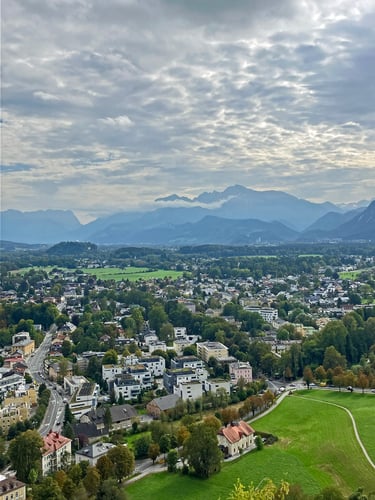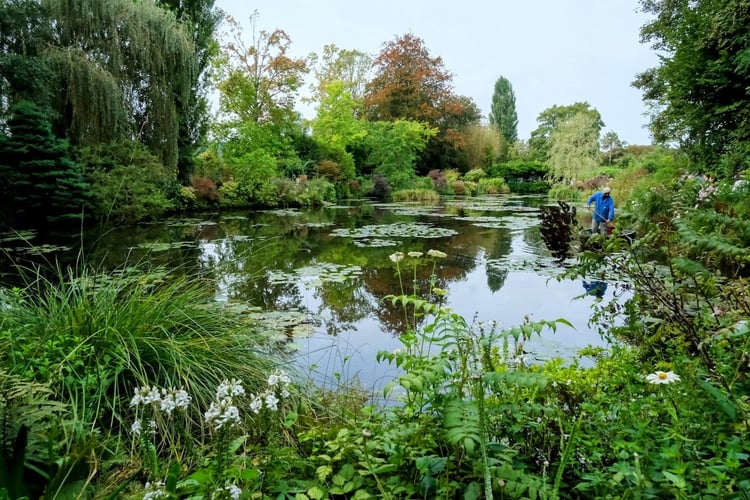
Paris Travel Guide
So you're planning a trip to Paris? Dive into our comprehensive Paris travel guide guide covering everything you need to know about the City of Light and the must-do experiences awaiting you.
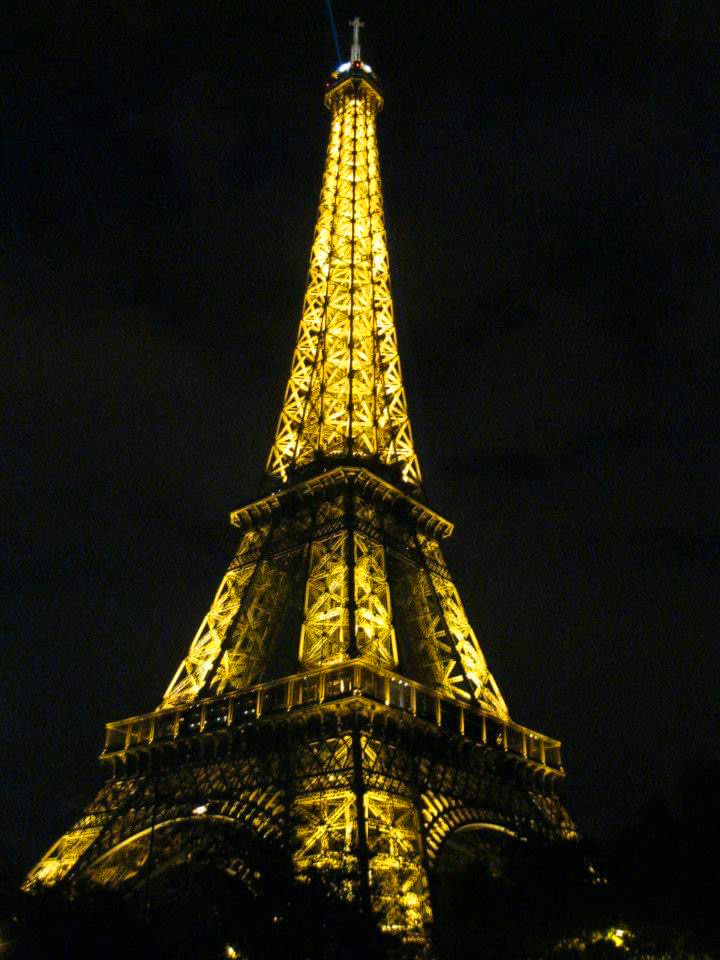
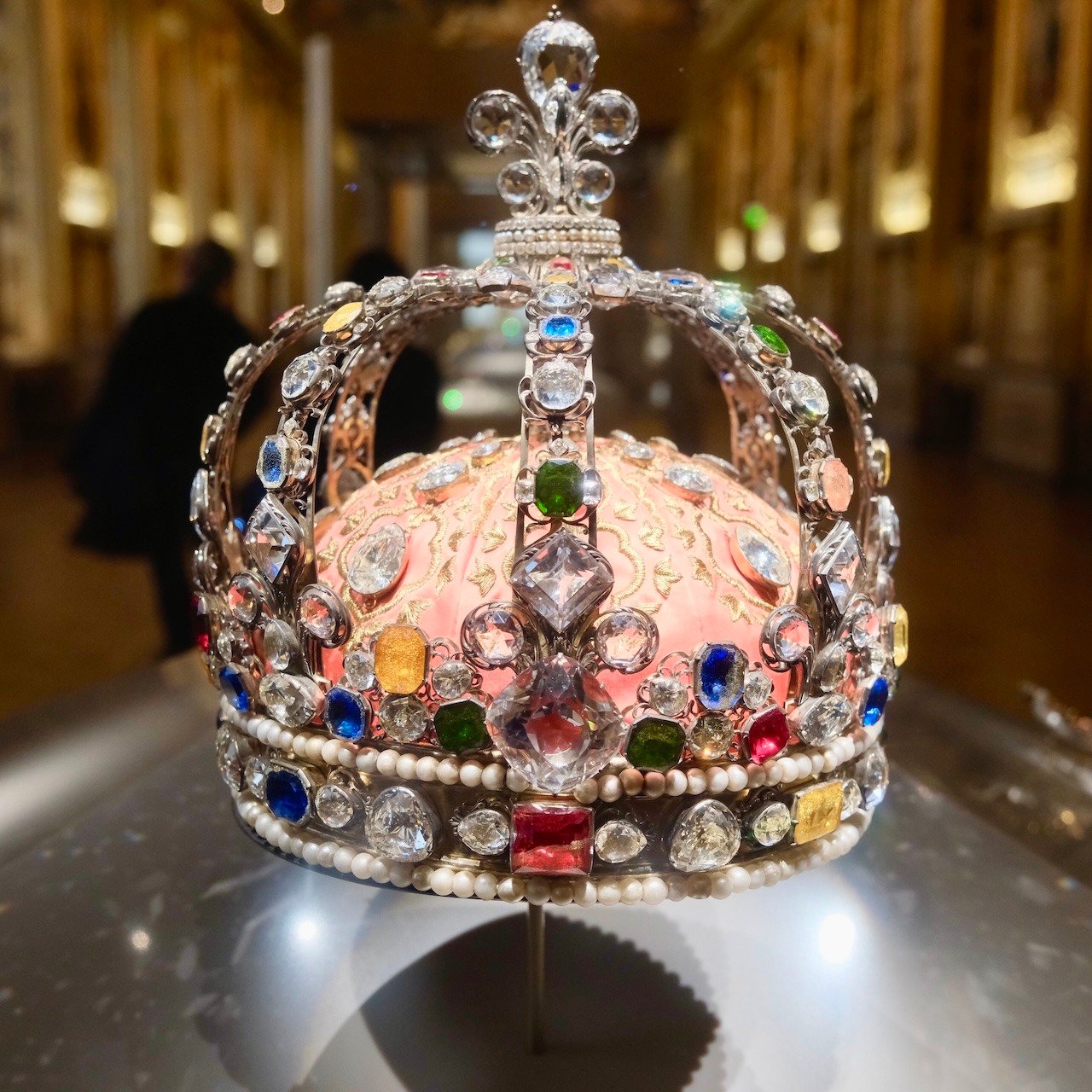
Paris Travel Guide
An Introduction
Nestled along the banks of the Seine River, Paris stands as an icon of culture, romance, and history. Known affectionately as the City of Light (La Ville Lumière), Paris radiates a timeless charm that has captivated visitors for centuries.
Paris boasts a rich history dating back more than two millennia. Founded by the Parisii tribe in the late 3rd century BC, it became the capital of the Frankish kingdom (also known as The Kingdom of the Franks or Francia) in the Middle Ages and later flourished as a center of art, philosophy, and politics during the Renaissance.
The French Revolution in the late 18th century was a significant period in Parisian history, leading to the overthrow of the monarchy and the establishment of the French Republic. The 19th century saw further transformation under the rule of Emperor Napoleon III and his prefect Baron Haussmann, who redesigned the city's layout, creating the wide boulevards and grand public spaces that define Paris today.
Renowned for its artistic treasures, Paris has been home to some of the world's greatest thinkers, artists, and writers. From the Impressionist masterpieces housed in the Musée d'Orsay to the iconic Louvre Museum, which houses the enigmatic Mona Lisa, the city's cultural institutions are a testament to its enduring artistic legacy.
- The nickname, "City of Light," originated not only from the city's leading role during the Age of Enlightenment but also because Paris was one of the first cities in Europe to adopt street lighting.
- The Eiffel Tower was once considered an eyesore! When it was first constructed for the 1889 Exposition Universelle (World's Fair/Expo), many Parisians criticized the Eiffel Tower, but it has since become one of the most recognizable structures in the world. Today, the Eiffel Tower, twinkles with 20,000 lights every hour after sunset until 1:00 AM, creating a breathtaking sight for onlookers.
- Paris has more than 400 parks and gardens which cover more than 7,400 acres. The city is dotted with beautiful green spaces like the Luxembourg Gardens, the Tuileries Garden, and Parc des Buttes-Chaumont.
Paris Travel Guide: Quick Tips
Paris Travel Guide: Can't Miss Attractions
No true Paris travel guide would be complete without a curated selection of the city's top sights! Paris is filled with iconic landmarks, charming cafés, and world-class museums. From seeing the Mona Lisa at the Louvre Museum, to ascending to the top of the Eiffel Tower to see the City of Light come to life at sunset, seeing Notre Dame rise from the ashes, and window shopping on Les Champs-Élysées, Paris has a lifetime of experiences awaiting you. Whether you have 24-hours or two weeks, these are the can't miss attractions in Paris!
We've highlighted all the attractions we visited and adored with the universal symbol of love, ♡.
- Louvre Museum (Musée du Louvre): ♡ The Louvre Museum is the world’s largest and most visited museum, housing an extensive collection of art and artifacts spanning thousands of years. Highlights include the enigmatic Mona Lisa by Leonardo da Vinci, the ancient Venus de Milo statue, and the majestic Winged Victory of Samothrace. The museum's vast galleries also showcase Egyptian antiquities, Renaissance masterpieces, and much more.
- Eiffel Tower (Tour Eiffel): ♡ The Eiffel Tower, an iconic symbol of Paris, offers stunning panoramic views of the city from its various levels. Visitors can enjoy dining at the tower’s restaurants or simply take in the fantastic vistas from the observation decks. Illuminated at night, it becomes a sparkling beacon over the Paris skyline.
- Musée d'Orsay: ♡ Located in a beautiful former railway station, the Musée d'Orsay is renowned for its impressive collection of Impressionist and post-Impressionist art. Notable works include Van Gogh’s Starry Night Over the Rhône and Seurat's The Circus. The museum also features sculptures, decorative arts, and photographs from the 19th and early 20th centuries.
- Notre Dame Cathedral (Cathédrale Notre-Dame de Paris): ♡ Notre Dame Cathedral is a masterpiece of French Gothic architecture, known for its stunning stained glass windows and imposing flying buttresses. Highlights include the rose windows, the gargoyles, and the breathtaking view from the bell towers. Despite the 2019 fire, the cathedral remains a symbol of Parisian resilience. Notre Dame reopened to the public in December 2024.
- Arc de Triomphe: The Arc de Triomphe stands at the top of the Champs-Élysées, honoring those who fought and died for France. Visitors can climb to the top for a panoramic view of Paris, including the Champs-Élysées and the Eiffel Tower. The Tomb of the Unknown Soldier and its eternal flame are located beneath the arch.
- Luxembourg Garden (Jardin du Luxembourg): Luxembourg Garden is a beautiful and expansive park perfect for leisurely strolls, picnics, and enjoying the outdoors. Voted the most beautiful garden in Europe, Luxembourg Garden is comprised of nearly 62 acres of landscaped gardens. Highlights include the Orangery, the Médicis Fountain, the Médicis Aqueduct, the Luxembourg Museum, and the beautifully manicured gardens. The park is a favorite spot for locals and visitors alike to relax and unwind.
- Basilica of Sacré Coeur de Montmartre (Basilique du Sacré-Cœur de Montmartre): The Basilica of Sacré-Coeur is located at the highest point in Paris, offering stunning views of the city below. The basilica's striking white dome and impressive interior, including the grand mosaic of Christ in Majesty, are highlights. The surrounding Montmartre neighborhood adds to the charm with its artistic vibe and quaint streets.
- Palais Garnier (Opéra Garnier): The Palais Garnier is a stunning example of 19th-century Beaux-Arts architecture and is home to the Paris Opera. Highlights include the grand staircase, the opulent foyer, and the magnificent auditorium adorned with Chagall’s colorful ceiling fresco. The building itself is a masterpiece and a must-see for its architectural splendor.
- Sainte-Chapelle: ♡ Sainte-Chapelle is renowned for its stunning stained glass windows, which depict over a thousand biblical scenes in vivid color. This Gothic chapel on the Ile de la Cité was originally built to house relics of the Passion of Christ. The upper chapel, bathed in the light of its towering windows, offers a breathtaking visual experience.

Paris Travel Guide: Iconic Landmarks & Monuments in the City of Light
Eiffel Tower (Tour Eiffel) ♡
The Eiffel Tower, designed by Gustave Eiffel to serve as the entrance to the 1889 Exposition Universelle (World's Fair/Expo), the Eiffel Tower is an iconic symbol of Paris and one of the most recognizable structures in the world. Standing 1,083 feet (330 meters) tall, the Eiffel Tower offers breathtaking panoramic views of Paris from its three observation decks. The first and second floors feature restaurants and shops, while the top level provides stunning views over the city. At night, the tower is illuminated by 20,000 light bulbs, creating a dazzling spectacle. The light show takes place beginning at sunset and then every hour, on the hour, until 1:00 AM. (During the summer, the light show runs an extra hour until 2:00 AM.) Visitors can take an elevator all the way to the top or climb 674 stairs to the second floor, where they can enjoy stunning views of the city below.
Due to the immense popularity of the Eiffel Tower, we recommend that you purchase your tickets in advance on the Eiffel Tower website, especially if you are looking to visit during the coveted sunset time slot. Purchasing tickets online will also save you time waiting in line at the Eiffel Tower's ticket office. The Eiffel Tower is open daily. The Eiffel Tower is located in the 7th Arrondissement in Paris within the Champ de Mars.
Arc de Triomphe
The Arc de Triomphe stands at the top of the Champs-Élysées, commemorating those who fought and died for France in the French Revolutionary and Napoleonic Wars. The Arc de Triomphe was commissioned by Emperor Napoleon I in 1806 to honor the French military victory at the Battle of Austerlitz in 1805. The Arc de Triomphe then took another 30 years to be completed. The arch’s design is Neoclassical and was inspired, in part, by the Arch of Titus in the Roman Forum in Rome, Italy. Visitors can climb 284 steps to the top for a view of Paris, including the Champs-Élysées, the Eiffel Tower, and beyond. The Tomb of the Unknown Soldier, interred beneath the arch in 1921, with its eternal flame, is a poignant tribute to the fallen.
The Arc de Triomphe is open daily, however, operating hours differ by season. The Arc de Triomphe is located in Place Charles de Gaulle in the 8th Arrondissement of Paris. To access the Arc de Triomphe, there is an underground pedestrian tunnel, the Passage du Souvenir, which can be accessed from the Avenue des Champs-Élysées or the Avenue de la Grande-Armée. Please do not run into oncoming traffic!
Place de la Concorde
Place de la Concorde is the largest square in Paris, located at the eastern end of the Champs-Élysées in the 8th Arrondissement. It is famous for its historical significance and striking landmarks, including the Luxor Obelisk, a 3,300-year-old Egyptian obelisk gifted to France in the 19th century. The square was a key site during the French Revolution, where King Louis XVI and Marie Antoinette were executed by guillotine. Today, the square is a bustling hub, adorned with fountains and statues, and offers magnificent views of the Champs-Élysées and the surrounding Parisian landmarks.
Palais Garnier (Opéra Garnier)
The Palais Garnier, designed by Charles Garnier, is a masterpiece of 19th-century architecture and home to the Paris Opera. Highlights include the grand staircase, the opulent foyer, and the stunning auditorium with Marc Chagall’s colorful ceiling fresco. The building’s opulent decor, intricate details, and historical significance make it a must-visit for art and architecture enthusiasts. While you are unlikely to encounter the Phantom of the Opera lurking in the shadows, the beauty and grandeur of this iconic landmark will certainly leave you spellbound. Self-guided and guided tours provide a fascinating glimpse into the history and grandeur of this iconic landmark.
The Palais Garnier is located in the 9th Arrondissement in Paris. Both self-guided and guided tours of the famed opera house are available and can be booked online. Due to upcoming performances, the auditorium may not be accessible during your visit. For additional information on operating hours and closures, please check the Palais Garnier website. Tickets for upcoming performances (opera, ballet, concerts, and recitals) can be purchased online on the Opéra National de Paris website.
Seine River
The Seine River flows through the heart of Paris, dividing the city into the Left Bank (Rive Gauche) and the Right Bank (Rive Droite). It is a defining feature of Paris, with many of the city's most iconic landmarks situated along its banks, including the Eiffel Tower, Notre Dame Cathedral, and the Louvre Museum. The river is lined with picturesque quays and bridges, such as the Pont Neuf and Pont Alexandre III, and is a popular route for sightseeing cruises, offering a unique perspective on the city’s beauty and history.
Panthéon
The Pantheon, located in the Latin Quarter, is a Neoclassical mausoleum that houses the remains of many of France’s most distinguished citizens, including Voltaire, Rousseau, Victor Hugo, and Marie Curie. Originally built as a church dedicated to St. Genevieve, it now serves as a symbol of French national pride. Highlights include the impressive dome, which offers panoramic 360° views of Paris, and Foucault’s Pendulum, demonstrating the rotation of the Earth. The Pantheon’s grand architecture and its role as a resting place for France’s great thinkers and artists make it a significant cultural landmark.
Pont Alexandre III
The Pont Alexandre III is widely regarded as the most beautiful bridge in Paris. Completed in 1900 for the Exposition Universelle (World's Fair/Expo), it connects the Champs-Élysées with the Hôtel des Invalides and the Eiffel Tower. The bridge is renowned for its ornate Art Nouveau design, featuring gilded statues, nymph reliefs, and intricate lamp posts. It offers stunning views of the Seine and is a popular spot for photographs and romantic strolls. The elegance and grandeur of Pont Alexandre III symbolize the opulence of the Belle Époque era.
Place du Trocadéro
Place du Trocadéro, situated in the 16th Arrondissement, is one of the most iconic and picturesque spots in Paris. It is directly across the Seine from the Eiffel Tower and offers some of the best panoramic views of this world-famous landmark, making it a prime location for photographs, especially at sunrise and sunset. The square is flanked by the Palais de Chaillot, which houses several museums.
Hôtel de Ville
The Hôtel de Ville, Paris’s City Hall, is an architectural masterpiece located in the 4th Arrondissement. The current building, completed in 1882, stands on the site of the original 14th-century city hall. It is the seat of the Paris City Council and the office of the Mayor of Paris. Highlights include the ornate Neo-Renaissance façade, the grand staircases, and the richly decorated reception rooms. The square in front, Place de l’Hôtel de Ville, often hosts events, ice skating in winter, and open-air exhibitions.

Paris Travel Guide: Top Paris Museums
Paris is filled with world-class museums, each offering a unique glimpse into art, history, and culture. When planning your visit, it is important to note that many Paris museums are closed on Mondays, with notable exceptions like the Louvre Museum, Musée de l'Orangerie, the Centre Pompidou, and La Galerie Dior which are closed on Tuesdays instead. Before planning your visit, make sure to check the most up-to-date opening hours, as public holidays may also affect museum schedules. Here is a guide to the top Paris museums that you will not want to miss!
For the art aficionado:
- Louvre Museum (Musée du Louvre): ♡ The Louvre Museum, originally constructed as a royal palace in the late 12th century, is now the world's largest art museum and a historic monument in Paris. It began as a fortress built under the direction of King Philip II and was transformed into a lavish palace by successive monarchs. Today, the Louvre’s vast collection spans over 9,000 years of history and includes works from ancient civilizations to the mid-19th century. Notable highlights include, of course, Leonardo da Vinci’s Mona Lisa, Venus de Milo, and the triumphant Winged Victory of Samothrace.
The museum also houses the French Crown Jewels, displayed in the Galerie d’Apollon, showcasing the opulence and grandeur of France’s royal history. Another highlight is the Napoleon III Apartments, a lavishly decorated series of rooms that offer a glimpse into the luxurious lifestyle of Emperor Napoleon III and his court. The Louvre’s glass pyramid entrance, designed by architect I. M. Pei, provides a striking modern contrast to the historic palace, blending the old with the new and inviting visitors into this extraordinary repository of art and history.
Due to the popularity of the Louvre Museum, advance tickets are recommended. Tickets can be purchased on the Louvre Museum website. The Louvre is located in the 1st Arrondissement of Paris, next to the Tuileries Garden and the Seine River. - Musée d'Orsay: ♡ The Musée d'Orsay is housed in a former Beaux-Arts railway station, Gare d'Orsay, which was built for the 1900 Exposition Universelle (World Fair/Expo). The museum itself is an architectural marvel, with its grand central nave, ornate ironwork, and sweeping glass ceilings. Renowned for its extensive collection of Impressionist and post-Impressionist masterpieces, the Musée d'Orsay is a treasure trove of 19th and early 20th-century art. Notable works include Van Gogh’s Starry Night Over the Rhône and Seurat's The Circus. The museum also boasts significant works by Cézanne, Degas, Manet, and Van Gogh, Additionally, the museum features sculptures, decorative arts, and photographs from the 19th and early 20th centuries.
The Musée d'Orsay is located in the 7th Arrondissement of Paris at 1 Rue de la Légion d’Honneur. Tickets to the museum can be purchased either online, or in-person. The busiest day to visit the Musée d'Orsay is Tuesdays, since the Louvre Museum is closed.
- Musée de l'Orangerie: Situated in the Tuileries Garden, the Musée de l'Orangerie is famous for its breathtaking display of eight of Monet’s Water Lilies. The museum also boasts an extensive collection of works by Cézanne, Matisse, Picasso, and other modern artists from the 20th century, housed in a beautiful and intimate setting. Musée de l'Orangerie is located in the 1st Arrondissement of Paris in the Tuileries Garden, near the Place de la Concorde.
- Centre Pompidou: The Centre Pompidou is a modern and contemporary art museum located in the 4th Arrondissement of Paris known for its radical architectural design. Highlights of its collection include The Frame by Frida Kahlo, Picasso’s La Muse, and Marc Chagall's The Bridal Pair with the Eiffel Tower. The museum also offers incredible views of Paris from its rooftop terrace.
The Centre Pompidou will be closing for renovations beginning in 2025 and will remain closed until 2030. Some of the museum's art, during this period, will be displayed in other museums around Paris. For the most up-to-date information on the planned renovations and closure, please check the Centre Pompidou website. - Musée Picasso: Housed in the elegant Hôtel Salé in Le Marais, the Musée Picasso holds one of the most comprehensive collections of works by Pablo Picasso in the world. Visitors can admire masterpieces including a self-portrait of Picasso from 1901, numerous sculptures, ceramics, and drawings that showcase the artist's prolific career.
- Musée Rodin: The Musée Rodin, set in the artist's former residence and studio in the 7th Arrondissement, features an extensive collection of Auguste Rodin’s sculptures, drawings, and photographs. Highlights include The Thinker and The Gates of Hell. The museum’s gardens provide a serene setting to appreciate Rodin’s monumental works.
- Fondation Louis Vuitton: Designed by architect Frank Gehry, the Fondation Louis Vuitton is a striking contemporary art museum and cultural center in the 16th Arrondissement of Paris. The foundation hosts rotating exhibitions of modern and contemporary art, including works by artists like Joan Mitchell, Damien Hirst, Andy Warhol, and Ellsworth Kelly.
- MAM Paris (Musée d'Art Moderne de la Ville de Paris): The Musée d'Art Moderne de la Ville de Paris, known as MAM for short, features an impressive collection of 20th- and 21st-century art. The museum is located in the eastern wing of the Palais de Tokyo in the 16th Arrondissement and its collection includes art from the likes of Pablo Picasso, Henri Matisse, Max Ernst, and more.
- Palais de Tokyo: The Palais de Tokyo is a leading contemporary art center in Paris in the 16th Arrondissement, known for its cutting-edge exhibitions and dynamic cultural programs. The space features works by avant-garde artists and hosts performances, installations, and multimedia art, making it a hub for contemporary creativity.
- Musée de Cluny: The Musée de Cluny, also known as the National Museum of the Middle Ages, is housed in a medieval mansion in the 5th Arrondissement and features an extensive collection of medieval art and artifacts. Highlights include the Lady and the Unicorn tapestries, Gothic sculptures, and illuminated manuscripts that provide a fascinating glimpse into the medieval world.
- Musée Marmottan Monet: The Musée Marmottan Monet boasts the largest collection of works by Claude Monet, including his famous painting Impression, Sunrise which gave the Impressionist movement its name. The museum also features works by other Impressionist and Post-Impressionist artists, as well as a collection of medieval and Renaissance art.The Musée Marmottan Monet is located in the 16th Arrondissement of Paris.
- Petit Palais & Musée des Beaux-Arts de la Ville de Paris: The Petit Palais, located across from the Grand Palais in the 8th Arrondissement, houses the Musée des Beaux-Arts de la Ville de Paris. Its collection includes a wide range of artworks from antiquity to the early 20th century. Highlights include The Little Alms Collector by Jan Steen and Knight, Death, and the Devil by Albrecht Dürer, as well as a stunning collection of decorative arts and sculptures.
For the history lover:
- Conciergerie: The Conciergerie, located on the Île de la Cité, is a former royal palace, the Palais de la Cité, courthouse, and prison that played a significant role during the French Revolution. It is famous for being the last place of imprisonment for Marie Antoinette before her execution. Highlights include the Hall of Men-at-Arms, one of the largest surviving medieval halls in Europe, and the prison cells, including a recreation of Marie Antoinette’s cell.
- Les Catacombes de Paris: While not quite a museum, the Catacombs of Paris are a fascinating and eerie underground ossuary located in the 14th Arrondissement. This extensive network of tunnels and chambers stretches over 200 miles beneath the city, but only a small portion is open to the public. Created in the late 18th century to address the problem of overflowing cemeteries, the Catacombs hold the remains of over six million Parisians. No tickets are sold on site. Tickets must be purchased online via the Catacombs website and may only be purchased 7 days in advance of your visit.
- Hôtel National des Invalides: The Hôtel National des Invalides is a grand complex of buildings in the 7th Arrondissement, originally constructed in the 17th century by King Louis XIV as a hospital and home for aged and disabled soldiers. Today, it houses several museums and monuments related to France's military history, the most prominent being the Musée de l'Armée (Army Museum). Highlights of the Army Museum include the grand tomb of Napoleon Bonaparte, located under the impressive golden dome of the Dôme des Invalides, and extensive collections of armor, weapons, and uniforms from various periods of French history. The site also includes the Musée des Plans-Reliefs (Museum of Relief Maps) and the Musée de l'Ordre de la Libération (Museum of the Order of the Liberation), making it a key destination for those interested in French military history. Admission to the Museum of Relief Maps and the Museum of the Order of the Liberation is included with your ticket to the Army Museum.
For the fashionista:
- Musée Yves Saint Laurent: The Musée Yves Saint Laurent Paris is dedicated to the life and work of the legendary fashion designer Yves Saint Laurent. Housed in the former haute couture house, where Saint Laurent worked for over 30 years, in the 16th Arrondissement at 16 Rue de la Pont de l’Alma. The museum showcases Saint Laurent's iconic designs, sketches, and personal artifacts. The museum offers an intimate glimpse into the creative genius of Yves Saint Laurent, with exhibitions that explore his groundbreaking contributions to women's fashion.
- Musée des Arts Décoratifs (MAD Paris): The Musée des Arts Décoratifs, also known as MAD Paris for short, is situated within the Palais du Louvre in the 1st Arrondissement of Paris. MAD Paris is a treasure trove of decorative arts and design. The museum’s extensive collection spans from the Middle Ages to contemporary design, with highlights including 17th-century furniture, Art Nouveau and Art Deco pieces, and contemporary design innovations. Notable exhibits often feature works by renowned designers and artisans, such as Jean Paul Gaultier.
- Palais Galliera (Musée de la Mode de la Ville de Paris): The Palais Galliera, also known as the Fashion Museum of Paris, is dedicated to the history of fashion. Located in the 16th Arrondissement, this elegant museum houses a vast collection of garments, accessories, and textiles dating from the 18th century to contemporary fashion. Highlights include pieces by Christian Dior, Alaïa, and Pierre Balmain. The museum’s exhibitions often explore specific themes or designers, providing deep insights into the evolution of fashion. The Palais Galliera is a must-visit for anyone interested in the artistry and history of fashion.
- La Galerie Dior: La Galerie Dior is located in the heart of Paris at 30 Avenue Montaigne in the 8th Arrondissement. La Galerie Dior is dedicated to the legacy of Christian Dior and his contributions to the world of fashion. The gallery offers a captivating journey through Dior’s iconic collections, showcasing his innovative designs, sketches, and haute couture creations. Highlights include pieces from the "New Look" collection, introduced in 1947, which revolutionized post-war fashion, and various pieces from subsequent designers who have upheld Dior’s legacy. The gallery also features temporary exhibitions that celebrate the brand’s history and artistic collaborations, making it a key destination for fashion aficionados.

Paris Travel Guide: Popular Churches
While Paris is dotted with spectacular churches, we have curated a list of some of the most popular ones for visitors to explore.
Notre Dame Cathedral (Cathédrale Notre-Dame de Paris) ♡
Notre Dame Cathedral, an architectural marvel of Gothic design, stands majestically on the Île de la Cité. Construction began in 1163 under the reign of King Louis VII and was completed in the mid-14th century. The cathedral is renowned for its stunning flying buttresses, intricate stained-glass rose windows, and the iconic twin bell towers that offer panoramic views of Paris. Throughout its history, Notre Dame has witnessed significant events, including the coronation of Napoleon Bonaparte as Emperor in 1804 and the beatification of Joan of Arc in 1909.
The cathedral's façade is adorned with detailed sculptures, including the Gallery of Kings, the Last Judgment Portal, and the famous gargoyles. Inside, the grandeur continues with the towering nave and the majestic Grand Organ, one of the largest in the world.
Unfortunately, in April 2019, a devastating fire severely damaged the cathedral, leading to an ongoing restoration project aimed at preserving and restoring this historic cathedral. Notre Dame reopened to the public in December 2024. Admission to Notre Dame is free of charge (Notre Dame's Treasury is a €12 charge for adults and €6 for children under 12); however, advance reservations are highly recommended to avoid waiting in a long line to enter the cathedral. Reservations can be made up to 3 days in advance of your visit on the Notre Dame website.
Sainte-Chapelle ♡
Sainte-Chapelle, another jewel on the Île de la Cité, is a masterpiece of Gothic architecture commissioned by King Louis IX to house his collection of Passion relics, including the Crown of Thorns. Completed in 1248, this royal chapel is renowned for its extraordinary stained glass windows, which cover nearly the entire height of the walls. These windows, comprising 15 massive panels, depict over 1,100 scenes from the Bible, creating a kaleidoscope of color and light that is truly breathtaking.
The lower chapel, initially used by the palace staff, features a richly decorated ceiling and vibrant murals. The upper chapel, reserved for the royal family and formerly containing the Passion relics, is a stunning example of the Rayonnant Gothic style, with slender columns and soaring arches that draw the eye upward to the dazzling windows. Advance tickets for Sainte-Chapelle are highly recommended. Arrive ahead of your ticket time as you will have to go through airport-like security before your visit.
Basilica of Sacré Coeur de Montmartre (Basilique du Sacré-Cœur de Montmartre)
The Basilica of Sacré Cœur, perched atop the hill of Montmartre in the 18th Arrondissement, is one of Paris’s most recognizable landmarks. Constructed between 1875 and 1914, the basilica was designed by architect Paul Abadie in a Romano-Byzantine style. The basilica's striking white domes and towers dominate the Paris skyline, and its grand Christ in Majesty mosaic is one of the largest in the world, covering over 5,112 square feet (475 square meters).
Visitors can also climb 280 steps to the top of the Basilica's dome for panoramic views of Paris. Tickets to climb the dome can be purchased on-site. The dome is open daily, but may close without advance notice due to inclement weather or maintenance. More information about the Dome Tour can be found on the Basilica's website.
Church of Sainte-Marie-Madeleine (La Madeleine)
The Church of Sainte-Marie-Madeleine, more commonly known as La Madeleine, is an imposing structure located near Place de la Concorde in the 8th Arrondissement. Designed to resemble a classical Roman temple, its construction began in 1764 and was finally completed in 1842, after disruptions related to the French Revolution. The church's massive Corinthian columns and grand portico make it a standout example of Neoclassical architecture. Inside, the church features a grand altar with a statue of Mary Magdalene and impressive frescoes. La Madeline's organ is also considered one of the best in all of Paris. During the church's construction, there were plans to turn the building into a library, a public ballroom, a marketplace, a temple to the glory of Napoleon’s army, and even a train station. However, those plans were ultimately abandoned and the Church was completed as intended and consecrated in 1842. La Madeleine has hosted the funerals of many famous musicians and artists, including Frédéric Chopin, Coco Chanel, and Joséphine Baker.
The Church of Saint-Germain-des-Prés is the oldest church in Paris, with its origins dating back to the 6th century. Located in the heart of the historic Saint-Germain-des-Prés neighborhood in the 6th Arrondissement, and giving the neighborhood its name, the church has a rich history that spans over 1,500 years. Originally part of a Benedictine abbey, the church has undergone numerous reconstructions and renovations over the years. The present structure of the church, built in the Gothic style, traces its origins back to the 11th century. The addition of its flying buttresses, a hallmark of Gothic architecture, came later, towards the close of the 12th century. Highlights of the church include its Romanesque bell tower, Gothic choir, and 13th-century frescoes in the Nave.
The Church of Saint-Étienne-du-Mont is located in the Latin Quarter in the 5th Arrondissement, near the Panthéon. Completed in 1626, it is known for its stunning architectural blend of Gothic and Renaissance styles. The church houses the tomb of Saint Genevieve, the patron saint of Paris, and is famous for its intricate rood screen. The rood screen, also called the jubé, separates the Nave from the choir. The screen was used as a platform for readings during mass. The church’s interior also features stunning stained glass windows and elaborate carvings, including on the organ case. Saint-Étienne-du-Mont’s rich history and architectural beauty make it a must-see for visitors exploring the Latin Quarter.
Saint Jacques Tower (Tour Saint-Jacques)
Saint Jacques Tower is a Gothic tower located in the 4th Arrondissement, near the Seine River and Rue de Rivoli. Originally part of the Church of Saint-Jacques-de-la-Boucherie, which was destroyed during the French Revolution, the tower is all that remains. Built between 1509 and 1523, the tower stands at 170 feet (52 meters) high and features intricate Gothic carvings and sculptures. It was a starting point for pilgrims on the Camino de Santiago (Way of St. James). Today, the tower is surrounded by a small park and offers guided tours that include a climb to the top, providing spectacular views of Paris. Its historical significance and architectural details make it an intriguing landmark. The tower is closed on Mondays and Tuesdays to visitors. Guided tours can be booked online, in advance, on the Saint Jacques Tower website.

Paris Travel Guide: Gardens & Parks
With over 400 parks and gardens in Paris, there is an abundance of green spaces to explore and enjoy whether for a picnic or a leisurely stroll. Here are some of the most popular ones:
Luxembourg Garden (Jardin du Luxembourg)
Luxembourg Garden, situated in the heart of the Left Bank in the 6th Arrondissement, is one of Paris's most beloved parks. Commissioned by Marie de' Medici in 1612, it spans almost 62 acres and was inspired by the Boboli Gardens in Marie de' Medici's native Florence, Italy. Luxembourg Garden is designed in the French formal style, with tree-lined promenades, meticulously manicured lawns, and vibrant flowerbeds. The garden features the Luxembourg Palace, now home to the French Senate, and the Medici Fountain, a romantic and serene spot popular with visitors. Other highlights include the Orangerie, the Pabellón Davioud, a replica of the Statue of Liberty in New York City, the Musée du Luxembourg, and numerous statues and sculptures scattered throughout the grounds. Opening hours of the Luxembourg Garden vary with the seasons. For the most up-to-date hours, please visit the Luxembourg Garden website.
Tuileries Garden (Jardin des Tuileries)
The Tuileries Garden, located between the Louvre Museum and Place de la Concorde in the 1st Arrondissement, is one of Paris’s most historic and elegant public gardens. Originally created by Catherine de' Medici in 1564 as the garden of the Tuileries Palace, the garden was later redesigned in the 17th century to give them their current French formal garden style. The garden features formal flowerbeds, a series of beautifully designed fountains, and three restaurants. The Tuileries is also home to the Musée de l'Orangerie, which houses Monet’s famous Water Lilies. Its central location and rich history make it a popular destination for leisurely strolls and cultural exploration.
Jardin du Palais Royal
The Jardin du Palais Royal, nestled behind the Palais Royal and close to the Louvre in the 1st Arrondissement, is a hidden gem in Paris. Created in the 17th century by Cardinal Richelieu, the garden is characterized by its serene atmosphere and elegant design. It features meticulously trimmed hedges, colorful flowerbeds, and sculptures. The garden is surrounded by arcades that house shops, cafés, and restaurants offering a unique blend of historical and contemporary charm.
Place des Vosges
Place des Vosges, located in the Le Marais neighborhood of the 4th Arrondissement, is one of the oldest squares in Paris, commissioned in 1605. The square is adorned with a central garden featuring elegant pathways, fountains, and the statue of Louis XIII on horseback. Place des Vosges has a rich cultural history and was once home to notable figures like Anne of Austria and Victor Hugo, whose former residence is now a museum open to the public in the square. The square’s charming setting and historical significance make it a popular spot for both locals and tourists.
Champ de Mars
The Champ de Mars is a vast green space stretching from the Eiffel Tower to the École Militaire in the 7th Arrondissement. Named after the Roman god of war, Mars, it was originally used as a military training ground. Today, it is a popular park offering stunning views of the Eiffel Tower, particularly spectacular during evening light shows. The park features wide lawns, tree-lined paths, and a playground, making it a favorite spot for picnics, leisure activities, and public celebrations. Its expansive open space and iconic location make Champ de Mars an essential part of the Parisian landscape.
Trocadéro Gardens (Jardins du Trocadéro)
The Trocadéro Gardens, located across the Seine from the Eiffel Tower in the 16th Arrondissement, offer some of the best views of the iconic landmark. These gardens were created for the 1937 Exposition Universelle (World's Fair/Expo) and feature a series of terraces, sculptures, and ornamental ponds leading up to the Palais de Chaillot. (The Palais de Chaillot also houses several museums and an aquarium.) The central feature of the gardens is the Warsaw Fountains, with its impressive water displays. The combination of stunning views of the Eiffel Tower, cultural attractions, and lush greenery makes the Trocadéro Gardens a must-visit destination in Paris.
Parc des Buttes-Chaumont
Parc des Buttes-Chaumont, located in the northeastern part of Paris in the 19th Arrondissement, is one of the city's largest and most picturesque parks. Opened in 1867 during the reign of Napoleon III and designed by Jean-Charles Adolphe Alphand, the park covers approximately 61 acres of hilly terrain, which was once a quarry and a refuse dump. The transformation into a lush green space was part of Baron Haussmann's extensive renovation of Paris.
The park is known for its dramatic landscapes, featuring steep cliffs, a man-made lake, and winding pathways. One of the park’s most striking features is the Temple de la Sibylle, a small pavilion inspired by the Temple of Vesta in Tivoli, Italy, perched atop a 30-meter-high rocky island in the center of the lake.
Other highlights of Parc des Buttes-Chaumont include a grotto and a suspension bridge, designed by Gustave Eiffel, which crosses the lake to the Belvedere island. The park is also home to a variety of plant species, making it a haven for nature lovers. Numerous lawns and picnic areas provide perfect spots for relaxation, while the park's undulating terrain makes it popular for jogging and leisurely strolls.
Parc des Buttes-Chaumont is a local favorite for its unique blend of natural beauty and dramatic scenery, offering a peaceful retreat.

Paris Travel Guide: Good Eats
The food in Paris is renowned for its exceptional quality and diversity, offering everything from world-class haute cuisine in Michelin-starred restaurants to delightful street food like crêpes and, of course, the iconic Parisian boulangeries and their fresh baguettes. The city's culinary scene is a celebration of French gastronomy, featuring exquisite pastries, artisanal cheeses, and an abundance of fresh, local ingredients that cater to every palate.
Bakeries:
Parisian bakeries, or boulangeries, are legendary for their craftsmanship and quality, offering a wide array of freshly baked goods daily. From the iconic baguette, with its crisp crust and soft interior, to buttery, flaky croissants, these bakeries are a cornerstone of Parisian life. Renowned pâtisseries also create exquisite pastries like éclairs, macarons, and tarts, making them must-visit spots for any food lover exploring the city. Some popular boulangeries and pâtisseries are below:
- Boulangerie Moderne (16 Rue des Fossés Saint-Jacques): A favorite among fans of Emily in Paris, this beloved artisanal bakery in the 5th Arrondissement is an essential stop for any visitor.
- Boulangerie Mamiche (45 Rue Condorcet): A traditional bakery in the 9th Arrondissement, specializing in artisanal breads, as well as babkas and viennoiseries (Viennese-style breakfast pastries).
- Boulangerie Utopie (20 Rue Jean-Pierre Timbaud): Located in the 11th Arrondissement, Boulangerie Utopie was founded by former pâtissiers from the famed Maison Laudrée in 2017. Their croissants are top-notch, but make sure you arrive early as they tend to sell out early in the day!
- Boulangerie Chambelland (Multiple Locations): The best gluten-free pastries and breads in Paris can be found at Boulangerie Chambelland. They have a few locations in Paris, but their most centrally located location is Chabelland Oberkampf (14 Rue Ternaux) in the 11th Arrondissement.
- The French Bastards / Boulangerie Pâtisserie Bastarderie (Multiple Locations): More than just Instagrammable desserts, The French Bastards offer both artisanal breads and baked goods. Their lemon tart and babka are crowd favorites!
- A. Lacroix Pâtisserie (11 Quai de Montebello): An ever-popular pâtisserie within view of Notre Dame Cathedral in the 5th Arrondissement, A. Lacroix Pâtisserie offers pastries almost too beautiful to eat! They also serve coffee and teas.
- Pâtisserie Stohrer (51 Rue Montorgueil): The oldest pâtisserie in Paris, founded in 1730, Pâtisserie Stohrer is located in the 2nd Arrondissement. If you visit, be sure to try the baba au rhum, a yeast cake soaked in rum. Baba au rhum is a creation of Pâtisserie Stohrer's founder, Nicolas Stohrer who was the head pastry chef to the King of Louis XV.
- Ritz Paris Le Comptoir (38 Rue Cambon): A luxurious extension of the renowned Ritz Paris, this bakery offers elegant pastries, viennoiseries, and exquisite treats. Le Comptoir is popular for its selection of glazed madeleines, including chestnut honey madeleines sold exclusively during the winter months.
- Aki Boulangerie (16 Rue Sainte-Anne): A Japanese-French fusion bakery, Aki Boulangerie is beloved for its unique offerings, such as matcha-flavored pastries, melon pan, and traditional French desserts with an Asian twist.
-
Biscuiterie de Montmartre (16 Rue Norvins): The best place for macarons in Paris, in Lauren's humble opinion, is Biscuiterie de Montmartre. Biscuiterie de Montmartre is located near the Place du Tertre in Montmartre. Lauren visited on her first trip to Paris in 2013 and has yet to find another spot to top them!
Best Bakeries in Paris Right Now >
Speciality Foods & Drinks:
Travelers visiting Paris should indulge in a variety of iconic dishes and treats that capture the essence of the city's culinary heritage. Some must-try Parisian specialties include:
-
Croissants & Pain au Chocolat: Classic breakfast pastries known for their buttery, flaky layers.
-
Baguette: The quintessential French bread, perfect for sandwiches or simply enjoyed with butter.
-
Croque-Monsieur and Croque-Madame: Traditional French grilled ham and cheese sandwiches, with the Croque-Madame topped with a fried egg.
-
Coq au Vin: This traditional French dish features chicken slowly braised in red wine, typically Burgundy, with mushrooms, onions, garlic, and bacon. The result is a rich, flavorful stew that is both hearty and sophisticated.
- Onion Soup (Soupe à l'Oignon): A comforting soup made with caramelized onions and beef broth, topped with melted cheese and croutons.
- Steak Frites (Entrecôte Steak Frites): A staple of French bistros, steak frites is a simple yet delectable dish consisting of a juicy steak, often cooked to perfection and served with a generous portion of crispy, golden fries. It is a quintessential Parisian meal that pairs wonderfully with a glass of red wine or a classic Béarnaise sauce.
- Macarons: Delicate almond meringue cookies with a variety of flavored fillings.
- Crêpes: Thin pancakes filled with sweet or savory ingredients, popular as street food or in crêperies.
Popular Restaurants:
The number of outstanding dining options in Paris could easily fill an entire website on its own! However, to guide you through the wonderland of Parisian and French cuisine that defines the city, we will highlight a few of the city's most popular eateries below.
- Le Relais de L'Entrecôte de Paris (Multiple Locations): Renowned for its only menu item - steak frites - Le Relais de L'Entrecôte de Paris is a more touristy spot than others on this list. They have three locations in Paris in Montparnasse, near the Luxembourg Garden, in St. Germain, and on Rue Marbeuf near the Avenue des Champs-Élysées.
- Bistrot Instinct (19 Rue de Picardie): Located in the heart of Le Marais, Bistrot Instinct is a contemporary bistro. Their menu is small, but everything is homemade - including their cocktail garnishes.
- Bistro Chez Pradel (168 Rue Ordener): Located in the 11th Arrondissement, Bistro Chez Pradel is a popular French bistro serving a variety of classic French dishes.
- Le Temps dos Cerises (31 Rue de la Cerisaie): Another spot featured on Emily in Paris, Le Temps dos Cerises is a traditional Parisian bistro open for breakfast, lunch, and dinner.
- Restaurant LE Drugstore (133 Av. des Champs-Élysées): A brasserie on the iconic Avenue des Champs-Élysées with a beautiful view of the Arc de Triomphe.
- Bouillon Chartier Grands Boulevards (7 rue du Faubourg Montmartre): This historic Parisian restaurant, the original Bouillon Chartier, is famous for its affordable classic French fare and vibrant Belle Époque decor. Fans of Emily in Paris may recognize it from the show. It doesn’t accept reservations, so arrive early or be prepared to wait. While this location is the most iconic, there are additional Bouillon Chartier locations around the city.
- Le P'tit Breton (12 Rue de Port-Mahon): A charming crêperie, Le P’tit Breton is a wonderful spot for a casual meal featuring savory galettes and sweet crêpes. We visited the location near Opéra and enjoyed a lovely lunch, but there are other locations scattered throughout Paris for you to try.
- Café de la Régence (167 Rue Saint-Honoré): Café de la Régence is a historic Parisian café with roots dating back to the 18th century, once a gathering place for intellectuals and chess enthusiasts. Today, it blends its storied past with a modern ambiance, offering classic French café fare, at a reasonable price point, in an elegant setting near the Louvre. No reservations are required.
- Le Moulin de la Galette (83 Rue Lepic): Tucked away in Montmartre, Le Moulin de la Galette is a historic restaurant set in a former mill. Known for its romantic atmosphere and refined French cuisine, it is a great choice for a special meal. Don't forget to try two of their specialities: Coq au Vin and Crêpes Suzette!
- Louis (23 rue de la Victoire): This Michelin-starred restaurant is an intimate gem in the 9th Arrondissement, celebrated for its inventive, seasonal French cuisine. With its understated elegance and chef-led attention to detail, Louis provides a sophisticated dining experience ideal for foodies seeking a creative twist on traditional French flavors.
- Le Train Bleu (Gare de Lyon): Housed in the Gare de Lyon, Le Train Bleu is a grand, historic restaurant with opulent Belle Époque decor. Known for its lavish setting and classic French menu, dining here feels like stepping back in time to the golden age of train travel. Whether you are catching a train or not, it is worth visiting for a truly memorable experience.
- La Méditerranée (Place de l'Odéon): Nestled on the Place de l’Odéon, this Bib Gourmand restaurant is known for its refined Mediterranean-inspired cuisine, with a focus on fresh seafood. Reservations are highly recommended.
- Le Jules Verne (Eiffel Tower): A French restaurant that is très iconique, Le Jules Verne is located on the second floor of the Eiffel Tower. While Le Jules Verne is absolutely a splurge on your trip to Paris, it comes with some of the most incredible views of the city and excellent food. It can be hard to snag a dinner reservation (reservations open 90 days in advance), so we actually recommend visiting for lunch!
Looking for additional restaurant recommendations for your trip to Paris? Check out the links below.
Popular Cocktail Bars & Nightlife Spots:
During our travels, we enjoy exploring cocktail bars and often rely on the The World's 50 Best Bars list to help us find some fantastic spots. Paris boasts several establishments from this list, highlighted below, along with additional spots we discovered based on the recommendations from others.
- Little Red Door (3rd Arrondissement)
- The Cambridge Public House (3rd Arrondissement)
- Danico (2nd Arrondissement)
- Bar Hemingway (1st Arrondissement)
- Le Syndicat (10th Arrondissement)
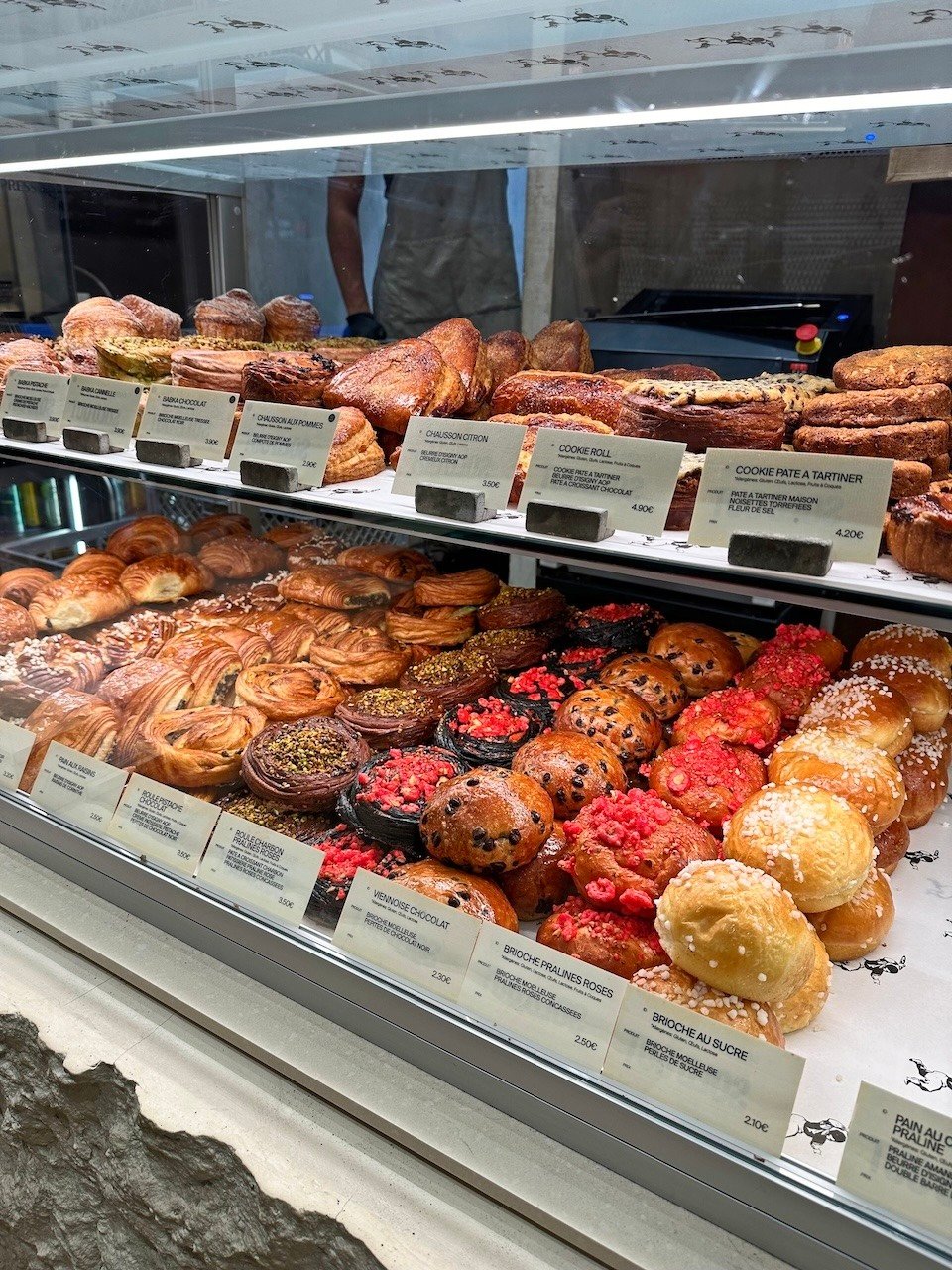
Paris Shopping Guide
Paris is a shopper's paradise. The city's diverse retail landscape ensures that every shopper, whether seeking high fashion, unique souvenirs, or gourmet treats, will find something to treasure. Some popular shopping areas in Paris include:
-
Champs-Élysées & Avenue Montaigne: The Champs-Élysées, stretching from the Arc de Triomphe to Place de la Concorde, is one of the most famous shopping streets in the world. It features a blend of luxury brands, flagship stores, and global chains. Just off the Champs-Élysées, Avenue Montaigne is home to the crème de la crème of Parisian fashion, including Dior, Chanel, Louis Vuitton, and other high-end designers, making it a prime destination for luxury shopping.
-
Le Marais: Le Marais, located in the 3rd and 4th arrondissements, is a historic district known for its narrow, cobblestone streets and charming boutiques. This trendy area offers a mix of high-end fashion, vintage shops, art galleries, and unique specialty stores. Visitors can find a variety of goods, from designer clothes and accessories to artisanal food products and home decor.
-
Saint-Germain-des-Prés: Saint-Germain-des-Prés, located in the 6th arrondissement, is known for its elegant atmosphere and a mix of high-end boutiques, bookshops, and antique stores.
- Rue de Rivoli: Rue de Rivoli, running parallel to the Seine in the 1st arrondissement, is a bustling shopping street that offers a mix of high-street fashion, souvenir shops, and department stores like BHV Marais. Its central location makes it a convenient shopping destination for tourists exploring nearby landmarks such as the Louvre and the Tuileries Garden.
- Galeries Lafayette & Printemps: Located on Boulevard Haussmann in the 9th arrondissement, Galeries Lafayette and Printemps are two of Paris’s most famous department stores. These iconic shopping destinations offer a wide range of luxury and mid-range brands, cosmetics, and gourmet food. The stunning architecture, including the glass dome of Galeries Lafayette, and the panoramic views from their rooftop terrace are additional attractions.
- Rue du Faubourg Saint-Honoré: Rue du Faubourg Saint-Honoré, situated in the 8th arrondissement, is another prestigious shopping street renowned for its haute couture boutiques and luxury fashion houses. The street is lined with high-end stores, including Hermès, Lanvin, and Yves Saint Laurent, as well as art galleries and upscale jewelry shops.
Popular Souvenirs from Paris
- Gourmet Foods: For food lovers, some top souvenir choices include French butter, known for its rich and creamy texture, and artisanal cookies like madeleines and macarons, which offer a taste of traditional French baking. Fine wines and champagne are also must-buys, with many shops offering selections from renowned French vineyards. Do not forget French chocolates and traditional French mustard to elevate your cooking once you return home. For one-stop shopping for all things gourment while in Paris, be sure to check out La Grande Épicerie de Paris in the 6th Arrondissement.
- Clothing & Accessories: Chic handbags from Polène and stylish clothing from Sézane are popular choices for their timeless Parisian flair. For those seeking high-end fashion, boutiques from iconic designers such as Chanel, Dior, and Louis Vuitton are essential stops. Accessories like scarves and silk ties from Hermès offer a touch of luxury and sophistication that can enhance any wardrobe. Note that if you are planning on visiting Hermès while in Paris, you will need a leather appointment in order to purchase any leather goods during your stay. Ready-to-wear and other accessories do not require an appointment.
- Looking for luxury pieces for less? Paris also has a fantastic selection of vintage and second-hand shops. Some of the best vintage stores in Paris are outlined in this fantastic article from Vogue.
- Beauty & Skincare Products: Beauty products are another excellent souvenir from Paris. Luxury perfumes from Fragonard capture the essence of French elegance, while skincare and beauty products from French pharmacies, such as La Roche-Posay, Avène, and Bioderma, are famed for their effectiveness and quality. French sunscreens are also top-notch, particularly those from La Rosée, Caudalie, La Roche-Posay, Avène, and Vichy! Artisan soaps from Savon de Marseille always make for lovely and practical gifts. For those looking to purchase beauty and skincare products from a French pharmacy, be sure to check out Citypharma in the 6th Arrondissement.
- Books & Stationery: Shakespeare and Company, a legendary English-language bookstore in the 5th Arrondissement, offers a selection of literary treasures.
Tax-Free Shopping in Paris:
Tax-free shopping in Paris allows non-EU residents to claim a refund on the Value Added Tax (VAT) paid on purchases. To qualify, you must be 16 years old and be visiting France for less than 6 months. You also must spend more than €100.00 in the same store, on the same day. When making a purchase, inform the retailer that you wish to shop tax-free. They will provide you with a tax refund form (detaxe form), which you need to complete. Ensure the retailer's details, your passport information, and purchase information are correctly recorded.
Before leaving the EU, you must have your tax refund forms validated by customs. At the airport, allow extra time to complete this process before your flight. Present your completed forms, passport, purchases, and receipts at the customs desk for stamping. This step is crucial, as you will not receive a refund without the customs stamp.
Global Blue, Planet Tax Free, and other tax-free companies facilitate the VAT refund process. The company that you need to provide your Tax-Free Form to after it has been validated should be clearly stated on your paperwork. You will need to provide them with your completed form, show your passport, and provide your contact information when processing the refund. Should you find yourself in a situation where mailing your Tax-Free Form becomes necessary, do not forget to take photos of all paperwork, including receipts, prior to mailing them off. Refunds processed via mail may take anywhere from 4-8 weeks, if not longer, to be received.
After a customs validation, you can receive your refund in cash immediately, or opt for a credit card refund, which typically processes within 3 to 5 days. The cash can be offered in both Euros and your home currency. Be sure to ask if any additional fees apply before selecting your choice of refund. It is important to note that not all purchases are eligible for VAT refunds, such as services and consumables. Additionally, there may be administrative fees deducted from your refund, so it is advisable to inquire about any potential fees before completing the tax-free shopping process. Additional information about tax-free shopping in Paris can be found on the Paris Aéroport website.
Paris Travel Guide: Transportation
Paris, the charming capital of France, can initially seem overwhelming to visitors due to its size and number of arrondissements. However, the city boasts an efficient public transportation system, including the Metro and local commuter trains (RER), which make it easy to explore its many neighborhoods and iconic landmarks. Using navigation aids like Google Maps can significantly enhance the ease and efficiency of navigating Paris’s diverse streets and attractions.
Airport:
Paris welcomes visitors through two main airports, easily connected to the city center.- Charles de Gaulle Airport (CDG) is the largest and busiest airport in Paris, serving as a major international hub.
- Orly Airport (ORY) is the second major airport in Paris, serving both international and domestic flights.
Transportation To/From CDG:
- RER Train Line B: The RER B suburban train connects CDG to central Paris. Trains run every 10-15 minutes, and the journey to Gare du Nord takes about 25 minutes. The RER B train line also runs to Châtelet Les Halles near the Louvre Museum, Saint-Michel-Notre-Dame in the 5th Arrondissement, and Luxembourg on the border of the 5th and 6th Arrondissements. There are two RER stations at CDG: Aéroport Charles de Gaulle 1 Station servicing Terminals 1 and 3, as well as, Aéroport Charles de Gaulle 2 TGV Station which services Terminal 2. The train runs every 10 to 15 minutes on weekdays.
- Roissy Bus: This direct bus service runs between CDG and Opéra in central Paris, with a journey time of approximately 60 minutes. The Roissy Bus runs every 15 to 30 minutes, depending on the time of day. The Roissy Bus picks up from all CDG terminals and stops only at Paris-Opéra (on the corner of Rue Scribe and Rue Auber).
- Taxi: Taxis are available at CDG, providing direct transportation locations within the city center. Taxi rates are a flat price of €56 if you are going to the Right Bank of the Seine and €65 if you are going to the Left Bank of the Seine. If you are planning on taking a taxi, be sure to get a taxi from the authorized taxi stands outside of the baggage claim exits. If someone approaches you inside the airport about a taxi or outside away from the proper taxi stand line, ignore them. These are scammers who do not operate licensed taxis. A real taxi will always have an illuminated sign and will charge the flat-rate pricing.
- Rideshare Apps: Uber operates in Paris. Prices for rideshare services are generally on par with traditional taxis. However, it is important to note that rideshare vehicles cannot linger at taxi stands or directly by the curb, so you may need to allow extra time for your ride to arrive after booking it at the airport.
Transportation To/From ORY:
- Orlyval and RER B Train: The Orlyval automated shuttle connects Orly Airport to the Antony RER B station, from where you can take a train to central Paris. The total journey time is about 25 to 35 minutes. RER Line B makes stops at Châtelet-Les-Halles and Gare du Nord.
- Orlybus: This direct bus service runs between Orly and Place Denfert-Rochereau in central Paris, taking around 30 minutes. The Orlybus runs every 10 to 15 minutes.
- Tramway T7 and Metro: The T7 tram connects Orly to the Villejuif-Louis Aragon metro station (Line 7), offering a more economical route to the city center. Travel time to the center of Paris takes approximately 80 minutes.
- Taxi: Taxis are available at ORY, providing direct transportation locations within the city center. Taxi rates are a flat price of €44 if you are going to the Right Bank of the Seine and €36 if you are going to the Left Bank of the Seine. If you are planning on taking a taxi, be sure to get a taxi from the authorized taxi stands outside of the baggage claim exits. If someone approaches you inside the airport about a taxi or outside away from the proper taxi stand line, ignore them. These are scammers who do not operate licensed taxis. A real taxi will always have an illuminated sign and will charge the flat-rate pricing.
- Rideshare Apps: Uber operates in Paris. Prices for rideshare services are generally on par with traditional taxis. However, it is important to note that rideshare vehicles cannot linger at taxi stands or directly by the curb, so you may need to allow extra time for your ride to arrive after booking it at the airport.
Local Transit:
To make the most of your time in Paris, the best way to see the city is undoubtedly by foot. However, in a city as large as Paris, using public transportation is also a necessity. The main means of public transportation in Paris are outlined below.
- Metro: The Paris Metro is one of the most iconic and extensive underground networks in the world, with 16 lines covering the city and surrounding suburbs. Each line is numbered and color-coded, with over 300 stations providing easy access to almost every corner of Paris. Trains run frequently from about 5:30 AM to 12:30 AM, extending to 1:30 AM on Fridays and Saturdays.
- RER: The RER (Réseau Express Régional) is a regional train network with five lines (A, B, C, D, and E) that connect Paris to its suburbs and beyond. The RER also serves major transit hubs within the city, such as Gare du Nord, Châtelet-Les Halles, and Luxembourg. Trains run from around 5:00 AM to midnight, providing a fast way to travel longer distances across the city and reach airports like Charles de Gaulle and Orly. The RER also runs to the Château de Versailles.
- Rideshare Apps: As previously mentioned, Uber operates in Paris. Rides can be easily requested from their respective apps. Rideshare apps are great for travelers concerned about the language barrier, those who are traveling to destinations within Paris that are not as readily serviced by other public transportation methods, and/or when traveling with luggage.
- Taxis: Taxi stands are readily available throughout Paris, making it convenient for residents and visitors to access taxi services. These taxi stands are typically located at key locations such as train stations, major squares, tourist areas, and hotels. As with any large city, make sure you are getting in an official taxi. When in doubt, have your hotel call a taxi on your behalf.
Ticketing & Tips
A single ticket, known as a T+ ticket, allows travel on the Metro, buses, trams, and the RER within central Paris (zones 1-2). Tickets can be purchased individually or in booklets of 10 tickets (carnets) for a discount. Navigo passes offer unlimited travel for a day, week, or month and are available for frequent travelers. Tickets can be purchased at vending machines and ticket offices in stations across the city. Contactless payment options with the Île-de-France Mobilités app for smartphones also provide a convenient way to purchase tickets and navigate the system.
Make sure you always validate your ticket before boarding, as inspections are frequent and fines for non-compliance are steep. If you are using a paper ticket, make sure you hold on to your ticket until the end of your journey.
Be mindful of peak travel times (8:00-10:00 AM and 5:00-7:00 PM) when the Metro and buses can be particularly crowded.
As always, be mindful of pickpockets on any public transportation in Paris. Keep your belongings secure by wearing bags across your body and keeping them zipped and in front of you. Avoid displaying valuable items like phones and wallets, and stay alert to your surroundings, particularly during rush hours.
Local & Long-Distance Trains:
Train Stations
Paris is a major hub for long-distance train travel, with several key train stations connecting the city to various domestic and international destinations. Some of the main long-distance train stations in Paris and some of the notable destinations they serve are outlined below.
Gare du Nord
- Gare du Nord is one of the busiest railway stations in Europe and serves as a major hub for both domestic and international travel. Gare du Nord is located in the 10th Arrondissement.
- The Eurostar runs from Gare du Nord to St. Pancras International in London, England. The journey takes approximately 2 hours. The Eurostar terminal within Gare du Nord is typically the busiest.
- Thalys trains also provide fast connections to Belgium, the Netherlands, and Germany from Gare du Nord.
Gare de l'Est
- Gare de l'Est is known for its striking Beaux-Arts architecture and is the oldest station in Paris. It is the departure point for high-speed trains to Strasbourg and other eastern cities. If you are visiting Épernay, Reims, or other towns within Champagne, you will likely leave from Gare de l'Est.
- International services connect Paris with major cities in Germany, Switzerland, and Luxembourg via Gare de l'Est.
- Gare de l'Est is located in the 10th Arrondissement, only a 10 minute walk from Gare du Nord.
Gare de Lyon
- Gare de Lyon is a major terminal for south-eastern destinations, known for its impressive Art Deco architecture. Gare de Lyon is located in the 12th Arrondissement.
- Gare de Lyon is the starting point for the TGV Lyria to Geneva and other high-speed trains to Italy (Turin and Milan), and Barcelona, Spain.
- Gare de Lyon also has trains running to other major French cities, including: Lyon, Marseille, Nice, Dijon, Aix-en-Provence, and the French Riviera.
Gare Montparnasse
- Gare Montparnasse is located in the 15th Arrondissement. The TGV Atlantique high-speed line runs from Gare Montparnasse to Brittany, Bordeaux, and the Spanish border.
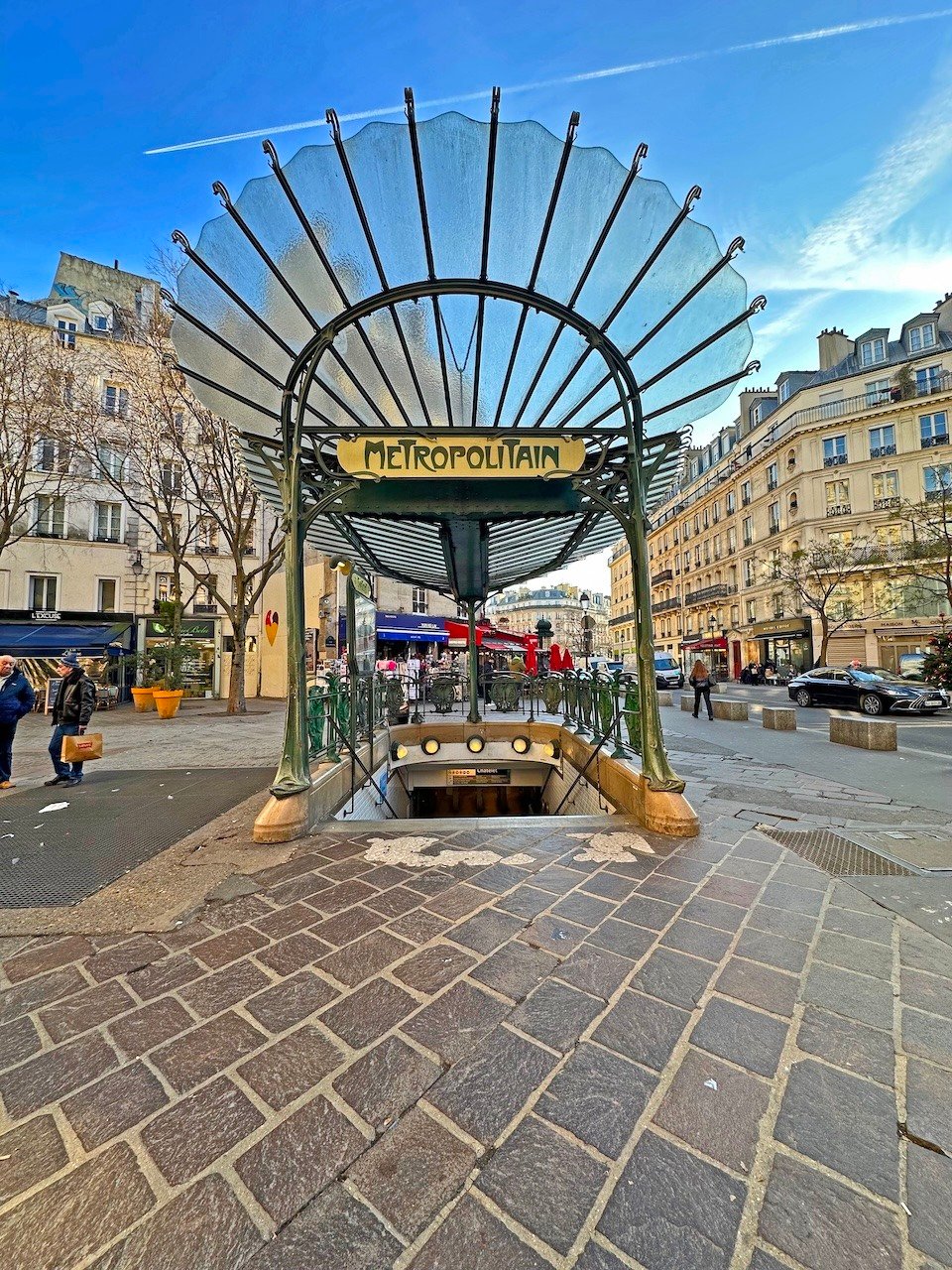

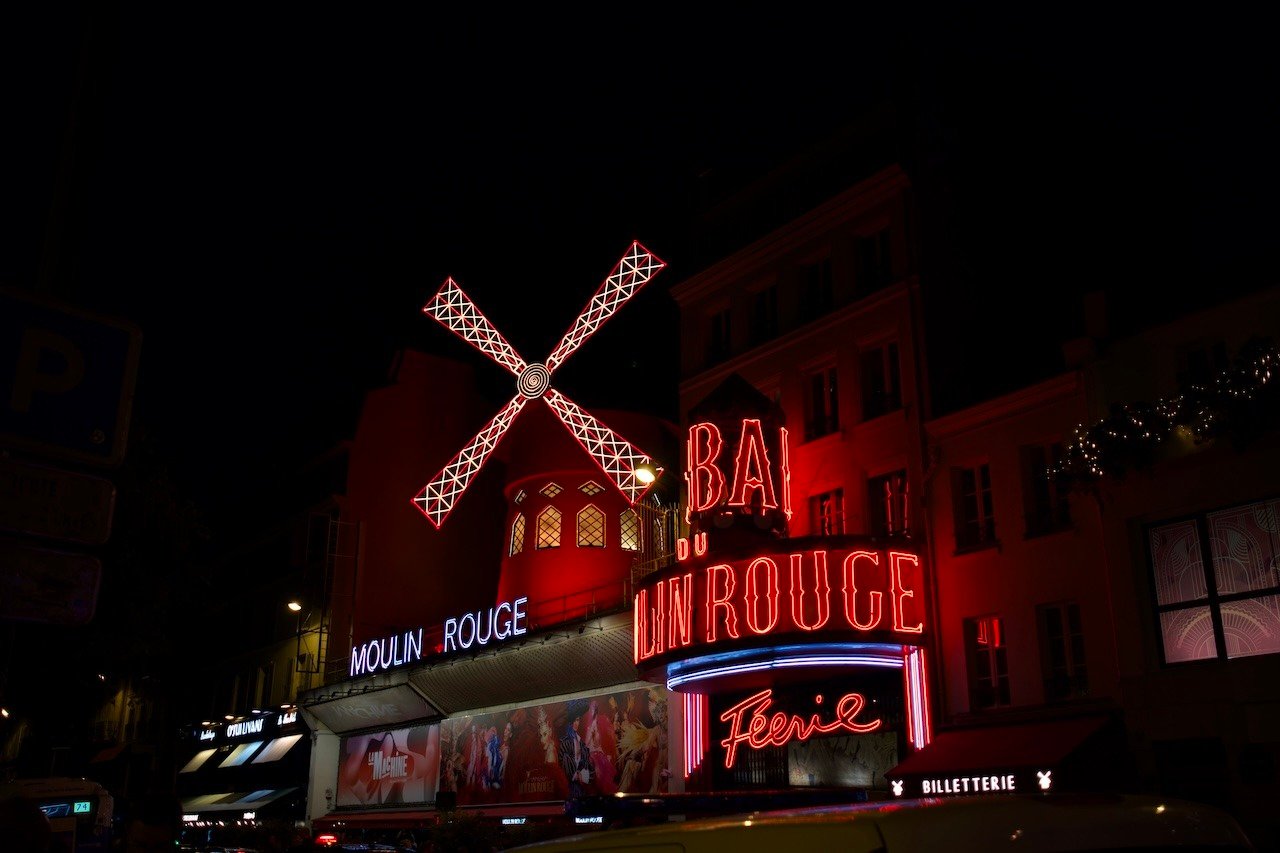
Why we love Paris
Paris holds a special place in our hearts. We have visited this magnificent city a three times together in three years and are always looking for another excuse to make our way back to the City of Light. The allure of Paris is undeniable, with its rich history, stunning architecture, and vibrant culture. It is a city that never ceases to enchant us, no matter how many times we visit.
One of the greatest aspects of Paris is its world-renowned museums. The Louvre, with its vast collection of art and historical artifacts, is an absolute must-visit. The Musée d'Orsay, housed in a former railway station, boasts an impressive array of Impressionist and post-Impressionist masterpieces. Every corner of Paris seems to be filled with art and history, making it a paradise for culture enthusiasts like us. And then there is the food – Parisian cuisine is truly top-notch. From delightful crêpes to exquisite pastries, every meal is more delicious than the last (can you tell we have a sweet tooth?!). The simple pleasure of enjoying a freshly baked croissant at a sidewalk café is something we always look forward to in Paris.
Montmartre, with its bohemian charm and artistic heritage, is one of our favorite neighborhoods in Paris. There is something magical about its winding streets, quaint cafés, and stunning views from the top of the hill. We also love taking a day trip to Versailles. The opulent palace and its expansive gardens never fail to leave us in awe. It is a phenomenal escape from the city, allowing us to step back in time and marvel at the grandeur of French royalty.
Shopping in Paris is an experience in itself. The city is home to some of the best shopping districts in the world, from the high-end boutiques on the Champs-Élysées to the quirky boutiques in Le Marais, and the iconic department stores of Galeries Lafayette and Printemps in the 9th Arrondissement. We always find ourselves browsing for hours, discovering unique items and indulging in a bit of retail therapy. Paris's blend of history, culture, food, and shopping makes it a city that we adore and look forward to revisiting time and time again.
Paris Neighborhoods
- 1st Arrondissement
- Le Marais
- Île de la Cité
- Latin Quarter
- St. Germain
- 7th Arrondissement
- 8th Arrondissement
- 9th Arrondissement
- Montmartre
1st Arrondissement: The Heart of Paris
The 1st Arrondissement, the very heart of Paris, is steeped in history and culture. It is home to the Louvre Museum, which boasts a vast collection of art, including the iconic masterpiece Mona Lisa. The serene Tuileries Garden, located just outside the Louvre, offers a peaceful retreat in the city center. Other notable sites include the Palais Royal with its stunning gardens and historic arcades, and the upscale shopping street of Rue de Rivoli.
The 1st Arrondissement is an ideal place to stay for art lovers and first-time visitors to Paris who want to immerse themselves in the quintessential Parisian experience, surrounded by historical landmarks and a vibrant cultural scene. The neighborhood is very walkable, with other popular neighborhoods, museums, and attractions nearby.

Le Marais
The 3rd and 4th Arrondissements are part of the historic Le Marais neighborhood, known for its trendy boutiques, art galleries, vibrant atmosphere, and Jewish heritage as the neighborhood was the former Jewish Quarter within Paris.
Le Marais is home to the Picasso Museum, which houses an extensive collection of the artist's works. The area is also known for the beautiful Place des Vosges, one of Paris's oldest and most charming squares, surrounded by elegant buildings and inviting cafés. Additionally, the Centre Pompidou is within Le Marais, which houses an impressive collection of modern and contemporary art.
Le Marais is the perfect location to stay in Paris for history enthusiasts and culture seekers who want to stay near the Seine and immerse themselves in the dynamic energy of Paris.
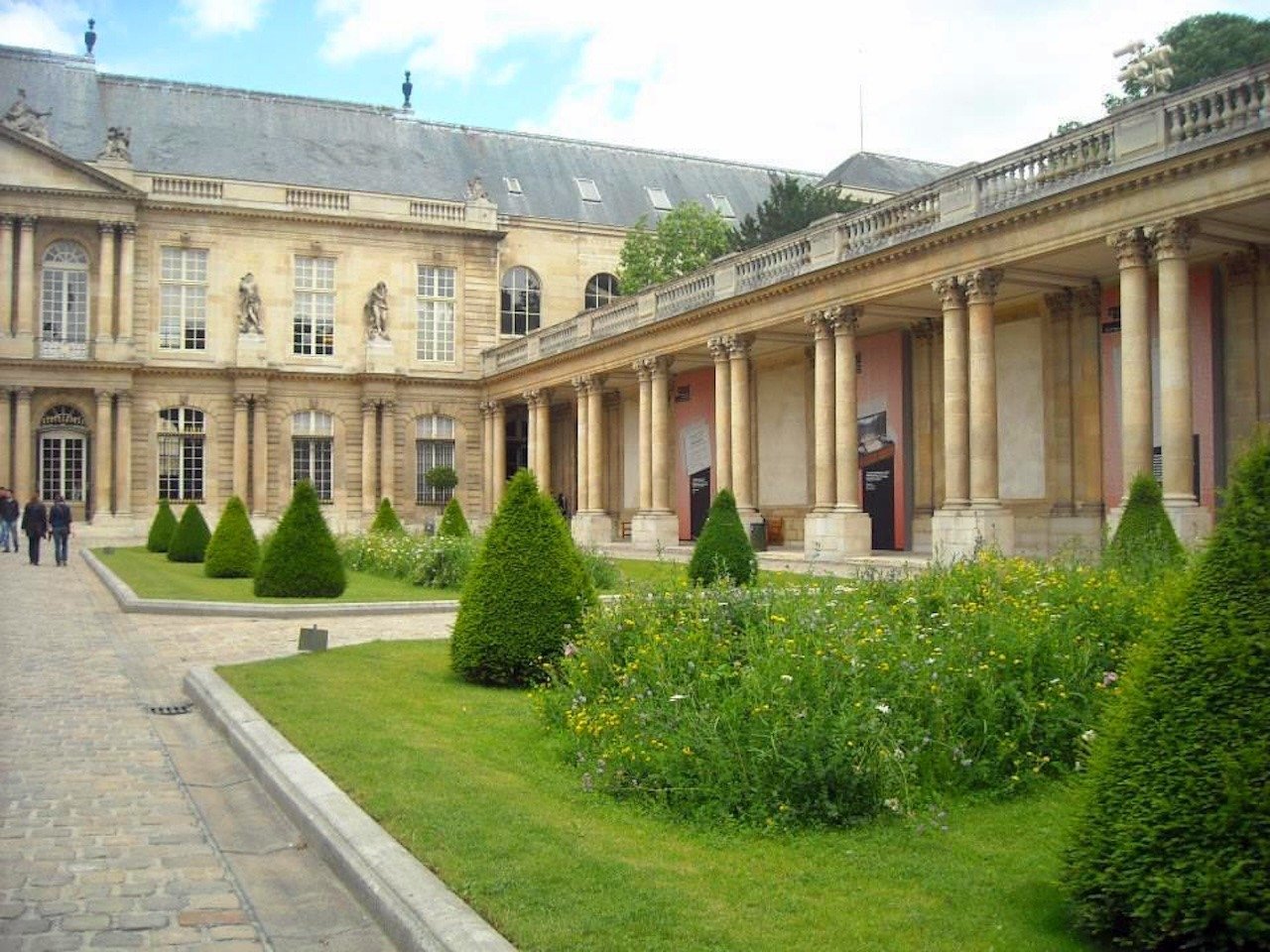
Île de la Cité
The Île de la Cité is one of the two natural islands in the Seine River within the city of Paris (the other is the Île Saint-Louis), and it is considered the historical heart of the city. The most famous landmark on the Île de la Cité is undoubtedly the Notre Dame Cathedral. This masterpiece of French Gothic architecture, with its stunning rose windows, flying buttresses, and gargoyles, has been a symbol of Paris for centuries. Although it suffered significant damage from a fire in 2019, restoration efforts are underway, and it continues to be a major tourist attraction.
Another gem on the island is the Sainte Chapelle, a royal chapel built in the 13th century. It is renowned for its magnificent stained-glass windows, which depict biblical scenes and flood the interior with vibrant colors, creating an ethereal atmosphere. Sainte Chapelle is often considered one of the greatest architectural masterpieces of the Gothic period.
Île de la Cité is also home to the Conciergerie and the Place Dauphine. The Île de la Cité is connected to both banks of the River Seine by the Pont Neuf. The Pont Neuf is the oldest standing bridge across the Seine, dating back to the 16th century. The bridge offers picturesque views of the Seine and the city, making it a favorite spot for both locals and tourists.
While hotels and vacation rentals are scarce on the Île de la Cité itself, its prime location at the heart of Paris ensures easy access by foot and metro to the surrounding city neighborhoods, inviting visitors to immerse themselves in the vibrant life and culture of the French capital.

Latin Quarter
The Latin Quarter, located in the 5th and part of the 6th Arrondissements, is one of Paris’s most historic and vibrant neighborhoods. Known for its academic legacy and bohemian spirit, this area has been a hub for scholars, writers, and artists for centuries. The Sorbonne Université is the heart of the Latin Quarter’s academic heritage. Established in the 13th century, it has been a center of learning and intellectual debate. In fact, the Latin Quarter’s name derives from the Latin language that was widely spoken in and around Sorbonne during the Middle Ages.
The Latin Quarter is also home to the Panthéon, a Neoclassical mausoleum where many of France's great minds, such as Voltaire, Rousseau, Victor Hugo, and Marie Curie, are buried. Additionally, the famous English-language bookstore, Shakespeare and Company, is located in the neighborhood.
The Latin Quarter is bustling with energy and is perfect for those who enjoy a lively, historic atmosphere filled with charming bookshops, cafés, and a rich cultural heritage. Staying in the Latin Quarter offers a unique blend of historical charm and vibrant city life. Accommodation options range from historic hotels to modern boutique lodgings, many of which are housed in centuries-old buildings. The area is centrally located and well-connected by metro and bus, making it easy to explore the rest of Paris.

St. Germain
St. Germain-des-Prés, or more simply St. Germain, located in the 6th Arrondissement, is one of Paris’s most elegant and historically significant neighborhoods. St. Germain is known for its literary and artistic heritage, stylish boutiques, and café culture.
The oldest church in Paris, St. Germain-des-Prés Church, dating back to the 6th century, is a centerpiece of the neighborhood. The church's Romanesque architecture and tranquil inner sanctuary offer a moment of calm amidst the lively city avenues.
Additionally, St. Germain is home to Café de Flore and Les Deux Magots. These two iconic cafés were once gathering places for literary and artistic luminaries like Jean-Paul Sartre, Simone de Beauvoir, and Ernest Hemingway. Today, they remain popular spots, albeit touristy ones, for enjoying a coffee and soaking in the neighborhood’s atmosphere.
The streets of Rue Bonaparte and Rue de Rennes are lined with chic boutiques, art galleries, and designer shops, offering a sophisticated shopping experience. The area is also known for its antique shops and bookstores, making it a paradise for collectors.
St. Germain is home to many upscale hotels and boutique accommodations, providing a comfortable and stylish base for exploring the rest of Paris. Its central location and excellent public transport connections make it easy to visit other parts of the city.
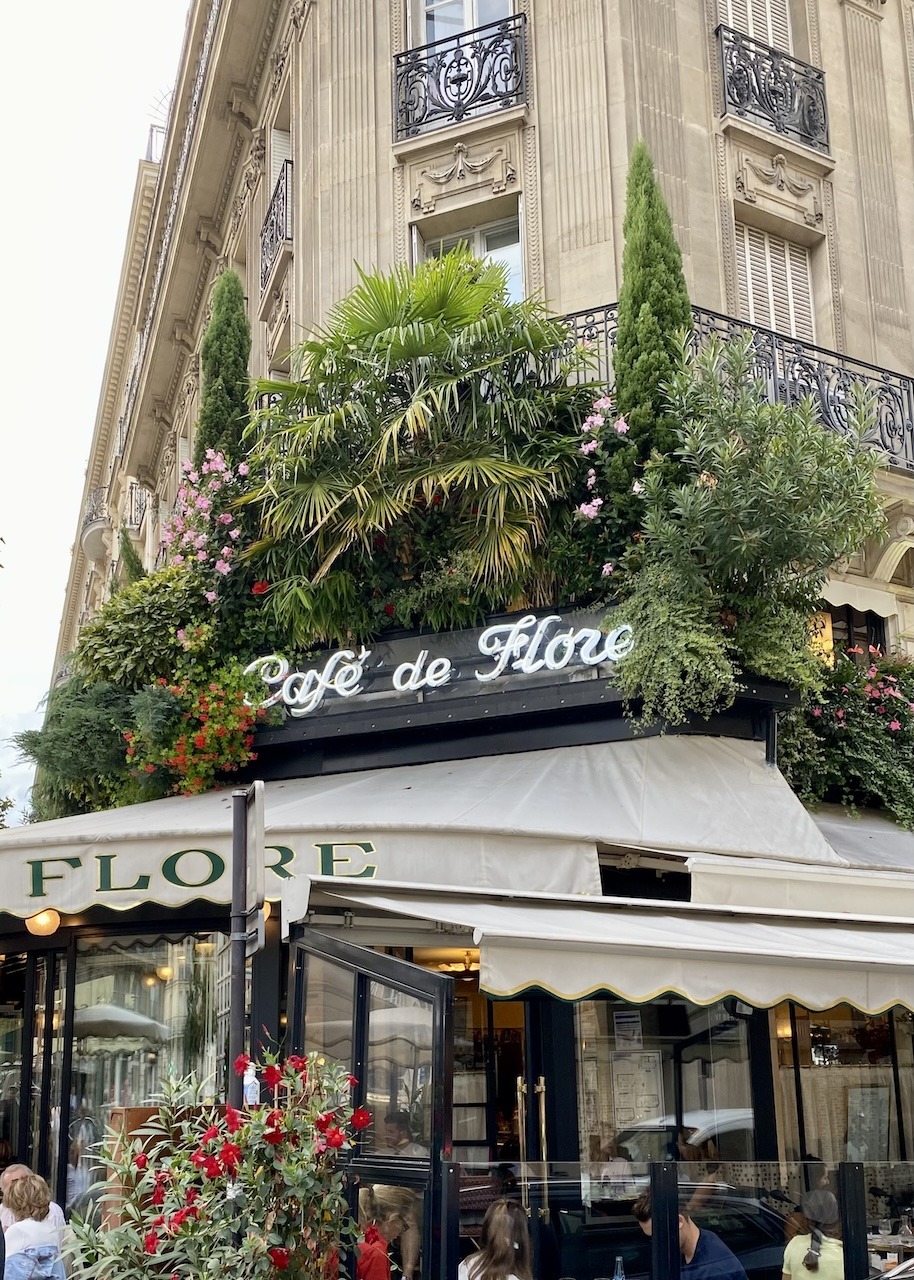
7th Arrondissement: Eiffel Tower, Musée d’Orsay, & Hôtel des Invalides
The 7th Arrondissement is a highlight of any trip to Paris, featuring the iconic Eiffel Tower, which offers stunning views of the city. It is also home to the Musée d’Orsay, which houses an extensive collection of Impressionist masterpieces, and the Hôtel des Invalides, where Napoleon Bonaparte is entombed. The Seine’s left bank adds to the charm with its picturesque riverside walks.
The area is perfect for first-time visitors and families who want to stay close to major landmarks and enjoy some of the best sights Paris has to offer.
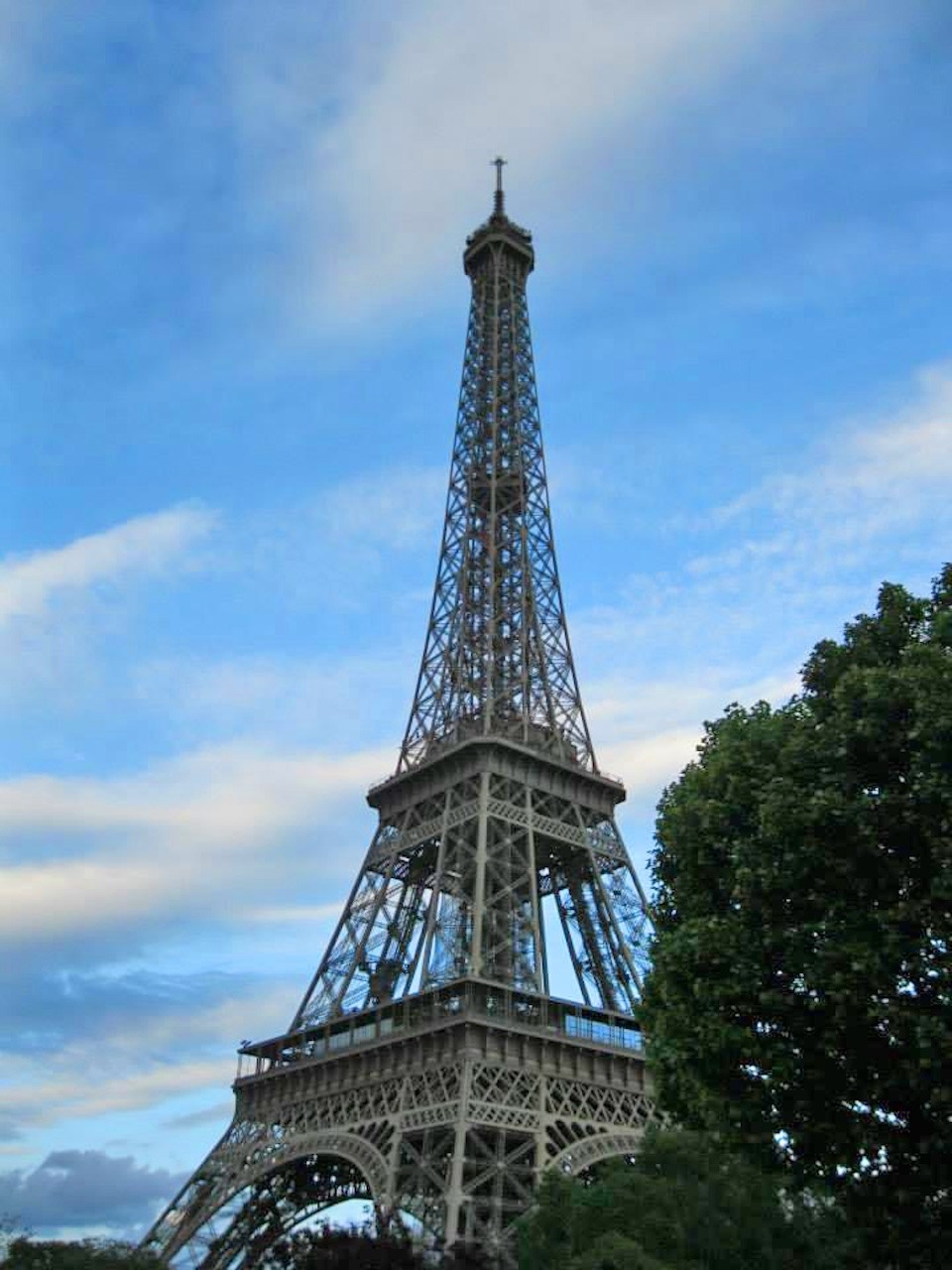
8th Arrondissement: Champs-Élysées & Arc de Triomphe
The 8th Arrondissement is synonymous with luxury and grandeur. It features the Arc de Triomphe, standing proudly at the top of the Champs-Élysées, one of the most famous avenues in the world, lined with upscale shops, theatres, and cafés. The area also includes the prestigious Avenue Montaigne, known for its high-end fashion boutiques. Additionally, the Grand Palais and Petit Palais offer cultural attractions with stunning architecture.
This arrondissement is ideal for luxury shoppers, history buffs, and those looking to be near major attractions in a sophisticated and vibrant setting.
Expedia's Guide to the 8th Arrondissement >
TheFork: 10 Best Restaurants in the 8th Arrondissement >
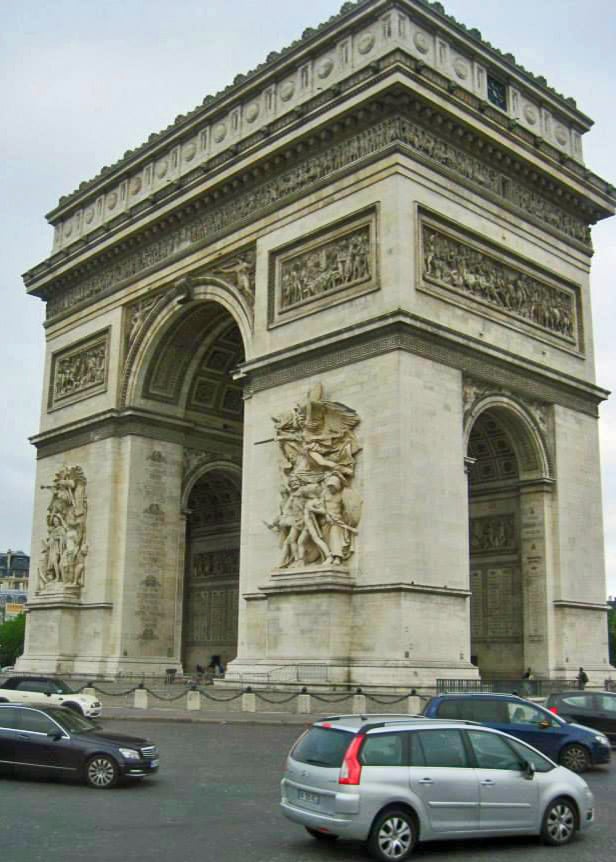
9th Arrondissement: Opéra Garnier & Galeries Lafayette
The 9th Arrondissement is a lively and diverse area, home to the magnificent Opéra Garnier, an architectural masterpiece and a cultural icon. The arrondissement is also known for its bustling shopping scene around the Galeries Lafayette and Printemps department stores. The area offers a mix of historic charm and modern amenities, with charming streets, theatres, and vibrant nightlife.
The 9th Arrondissement is perfect for shoppers, theatre-goers, and those who want a central location with a lively, local vibe, offering a blend of cultural and commercial activities. Another benefit of staying in the 9th Arrondissement is the RoissyBus, a direct shuttle service that runs between Opéra Garnier and Charles de Gaulle Airport.
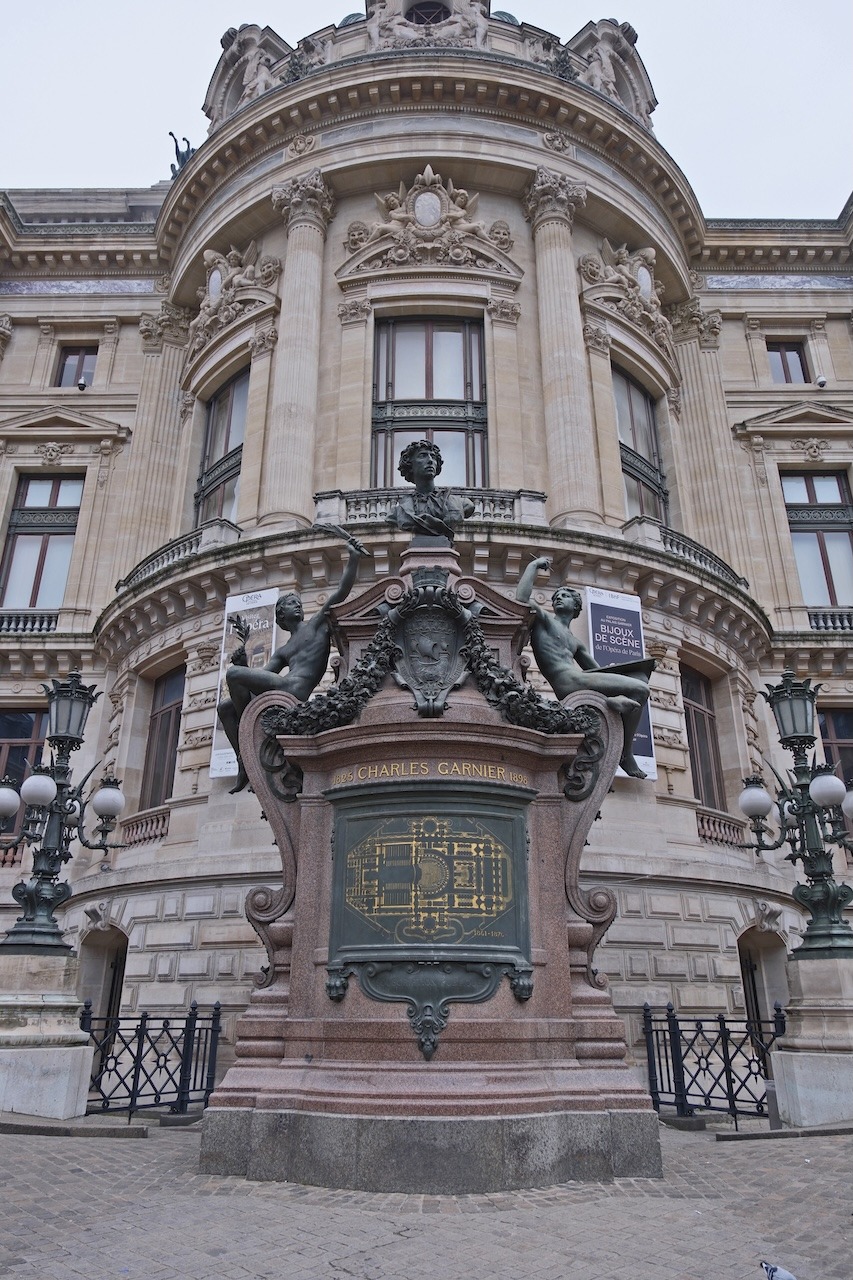
Montmartre
Montmartre, perched atop a hill in the 18th Arrondissement, is one of Paris's most beautiful neighborhoods, known for its bohemian charm, artistic heritage, and stunning views over the city. This area has been a haven for artists and creatives for centuries, making it a vibrant and historically rich part of Paris.
The crown jewel of Montmartre is the Basilica of the Sacré Cœur, a stunning white-domed church that sits at the highest point in Paris. Built in the late 19th century, it offers breathtaking panoramic views of the city from its dome. The Basilica's interior is equally impressive, with beautiful mosaics and a serene atmosphere for contemplation.
Staying in Montmartre offers a different perspective on Paris. The neighborhood is known for its charming, boutique hotels, and guesthouses that provide a cozy and intimate atmosphere. While it is somewhat removed from the city center, Montmartre is well-connected by metro and bus, making it easy to explore other parts of Paris.

Our Take on Paris
Over the years, we have stayed in a number of different hotels in Paris and in a variety of neighborhoods. Each stay has given us a new perspective on this beautiful city. While Montmartre is our favorite neighborhood to explore, with its bohemian charm and artistic heritage, it is not the most centralized location to stay in when visiting Paris. We have instead found that staying in more centrally located areas like the 1st Arrondissement, 7th Arrondissement, and/or the 9th Arrondissement provides a more convenient base for exploring Paris.
The 1st Arrondissement, home to the Louvre Museum and the Tuileries Garden, is incredibly central and allows easy access to many of Paris's top attractions. The 7th Arrondissement, where the iconic Eiffel Tower stands, offers beautiful streets and the picturesque Champ de Mars park. Lastly, the 9th Arrondissement, known for its grand boulevards and the magnificent Palais Garnier opera house, is lively and full of great shopping and dining options. Although these neighborhoods can be on the pricier side and the hotels are often equipped with smaller rooms, their centralized location makes them worthwhile.
Paris is best seen on foot, and having a hotel within walking distance of the major attractions allows us to fully immerse ourselves in the city's charm. We love strolling through the picturesque streets, discovering hidden gems, and stopping at delightful cafés along the way. Being centrally located means we can easily walk to iconic sites like the Louvre, the Seine River, and the Eiffel Tower, making our Parisian experience even more enjoyable and enriching. Here are some of the hotels we have stayed at, or family have stayed at, that we can highly recommend in Paris:
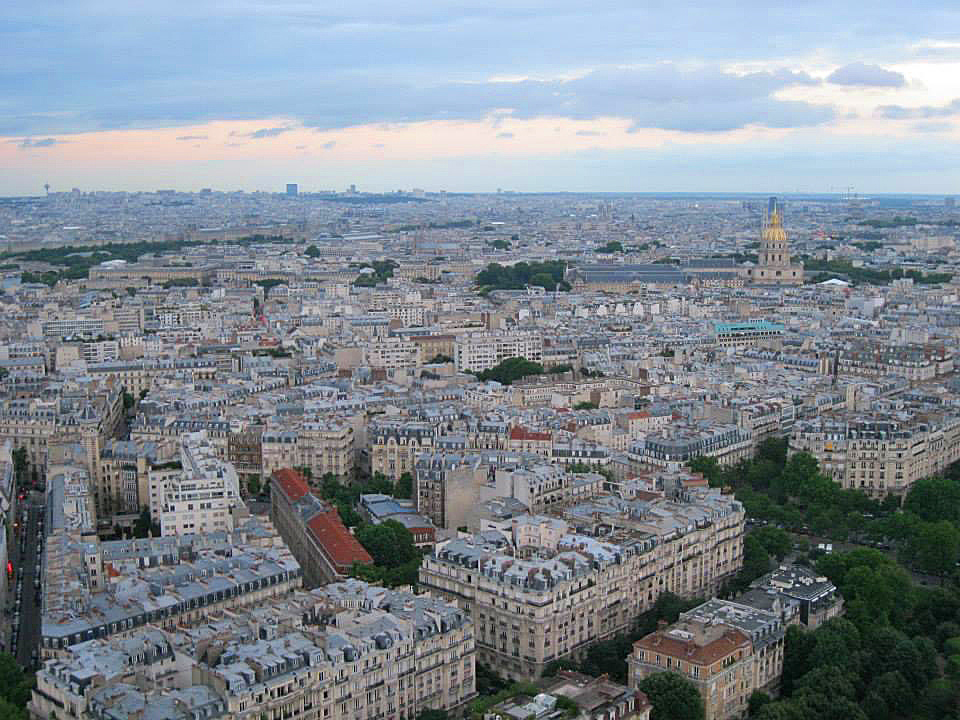

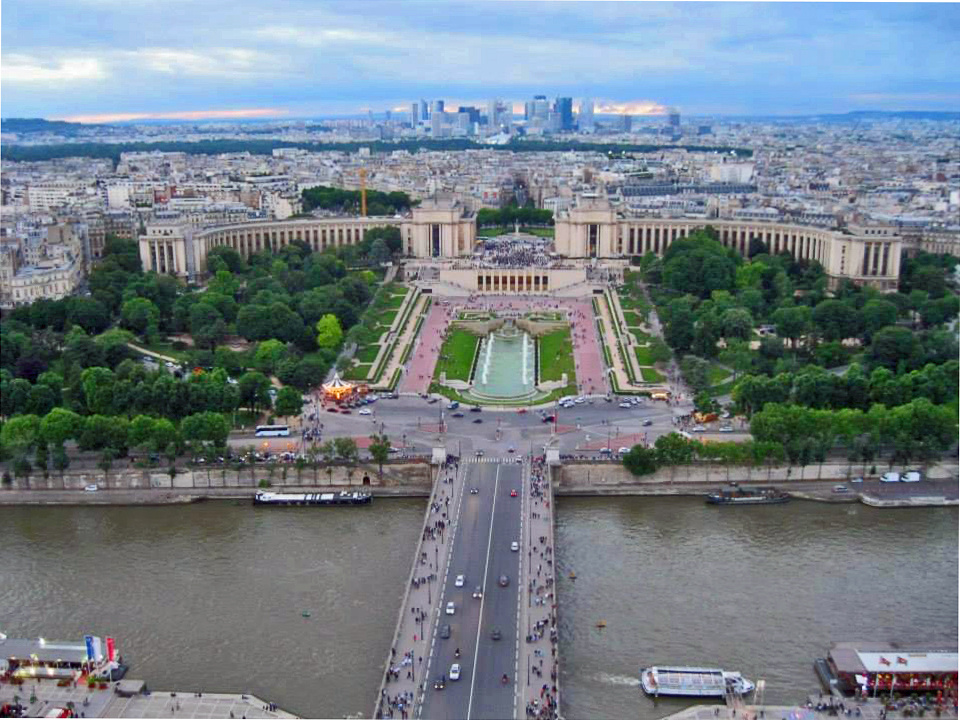
Day Trips from Paris
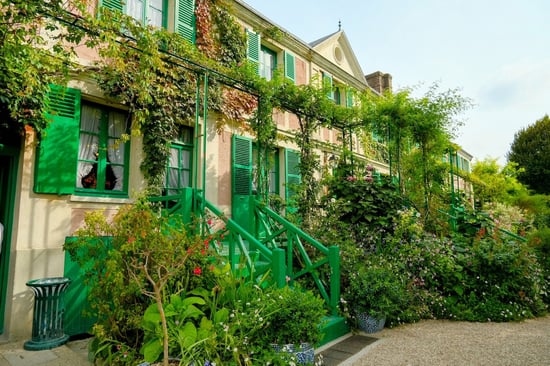
Giverny (Claude Monet's Garden)

Reims (Champagne)
Paris Travel Guide: Additional Resources for Visiting the City of Light
-

A Comprehensive Guide
to the Best Day Trips
from Paris
-

Three Not-So-Secret
Paris Hidden Gems
(Coming Soon)
-

Your Guide for Traveling from
Paris to Champagne
(Coming Soon)
Paris Travel Guide: One Last Note
Disneyland Paris
Disneyland Paris, despite its name, is not actually located within the city of Paris. It is situated in Marne-la-Vallée, a suburb about 20 miles (32 kilometers) east of the Paris city center, making it easy to spend a day at Disneyland during your time in the City of Light. Disneyland Paris features two distinct parks: Disneyland and Walt Disney Studios, along with a range of hotels, restaurants, and entertainment options. To reach Disneyland Paris from the center of Paris, visitors can take the RER A train from central Paris stations like Châtelet-Les Halles or Gare de Lyon, which will take them directly to Marne-la-Vallée/Chessy station in approximately 35-40 minutes. Disneyland Paris also operates an express bus from four locations within Paris: Eiffel Tower, Opéra, Châtelet, and Gare du Nord. Additional information on the express bus can be found on the Disneyland Paris website. A direct, TGV high speed train is available from Paris Charles de Gaulle Airport to Marne-la-Vallée/Chessy station. The ride takes approximately 12 minutes.
Tickets for Disneyland Paris must be purchased online, in advance of your visit on the Disneyland Paris website. Tickets for Disneyland Paris must be booked a minimum of eight days before your planned visit. Discounted tickets are available for children aged 3 to 11. Children under the age of 3 are free.
Looking for more Paris content?
Check out the Jetset Seeker Blog!


Looking for more Vienna content?
Check out the Jetset Seeker Blog!
Nearby Destinations
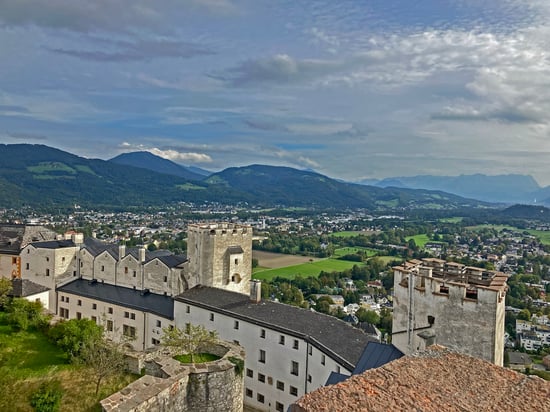
Salzburg, Austria

Munich, Germany
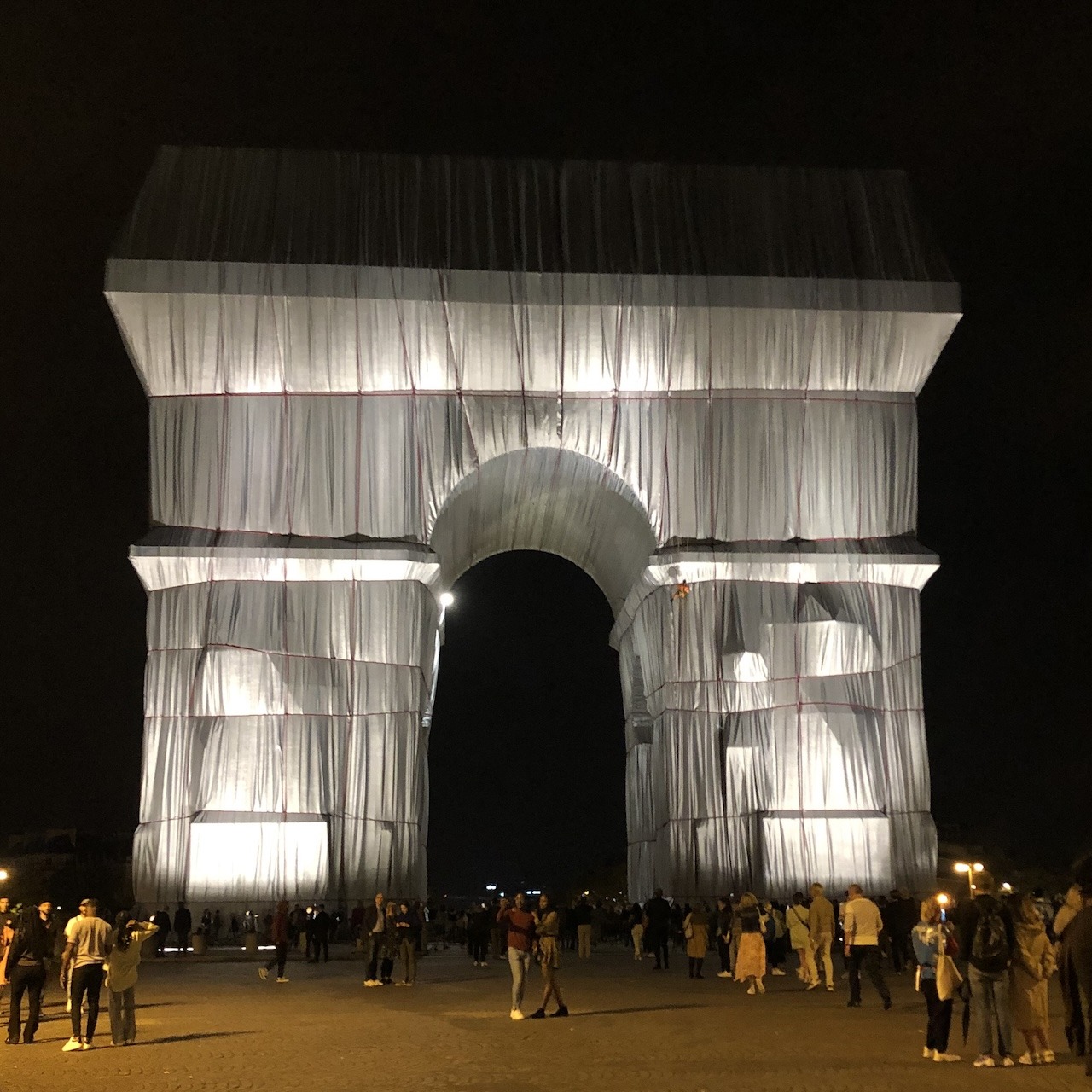
Our Paris Travel Guide & Trip Planning Resources
Curious about the resources that shaped our trip to Paris? Dive into the links below for additional insights and valuable information we used to plan our own trip.
What other honeymooners say


Laboris nisi ut aliquip ex ea commodo consequat. Duis aute irure dolor in reprehenderit in voluptate velit esse cillum dolore eu fugiat nulla pariatur. Excepteur sint occaecat cupidatat non proident, sunt in culpa qui officia deserunt mollit anim id est laborum.”

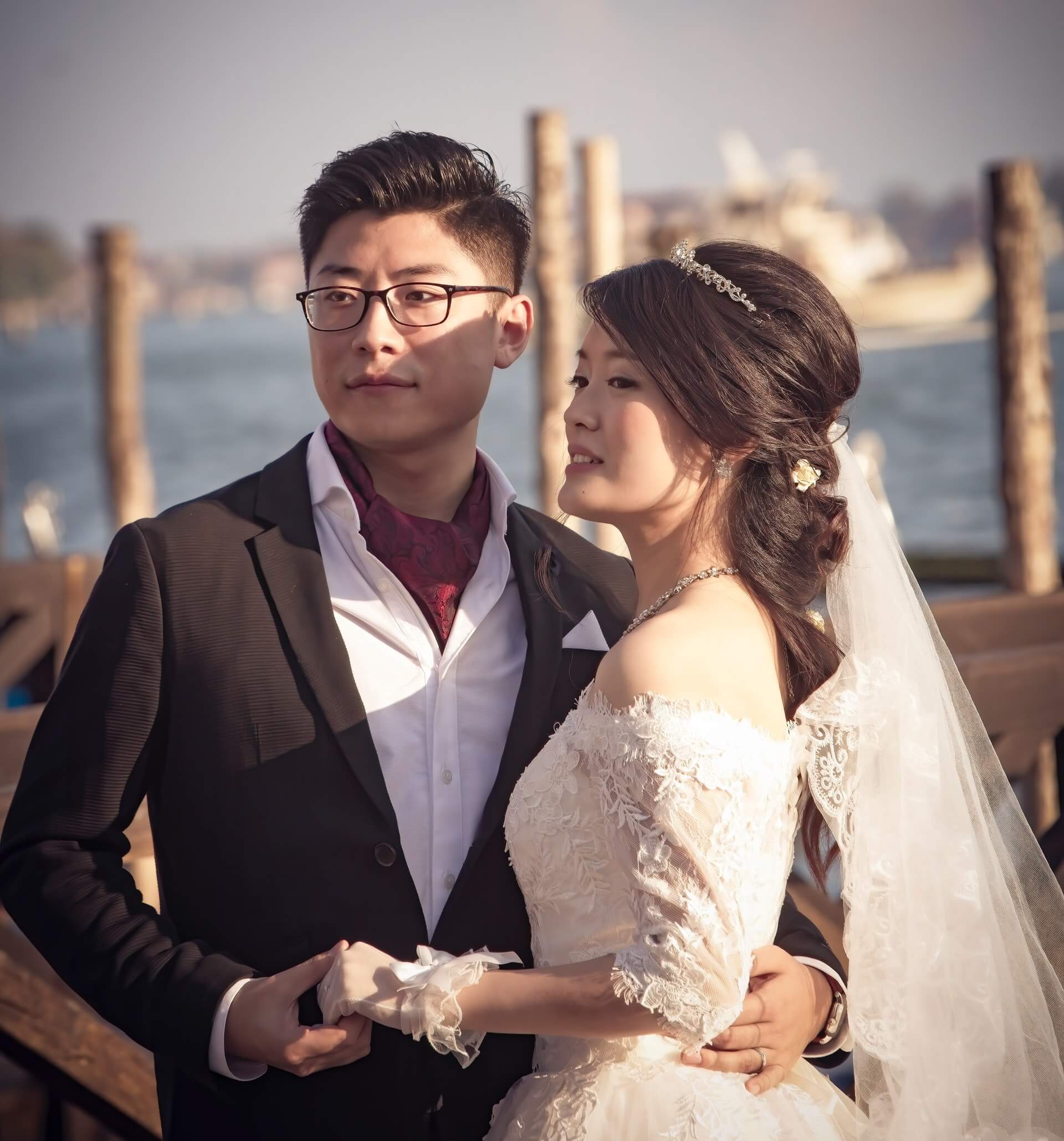
Laboris nisi ut aliquip ex ea commodo consequat. Duis aute irure dolor in reprehenderit in voluptate velit esse cillum dolore eu fugiat nulla pariatur. Excepteur sint occaecat cupidatat non proident, sunt in culpa qui officia deserunt mollit anim id est laborum.”


Laboris nisi ut aliquip ex ea commodo consequat. Duis aute irure dolor in reprehenderit in voluptate velit esse cillum dolore eu fugiat nulla pariatur. Excepteur sint occaecat cupidatat non proident, sunt in culpa qui officia deserunt mollit anim id est laborum.”
Tokyo Itineraries


%20(1).png?width=3690&height=2079&name=Jetset%20Seeker%20Logo%20(Banner)%20(1).png)








